|
The history of ancient India is
largely a history of Hindu culture and progress. Hindu culture has a
distinct claim to a higher antiquity than Assyrian schools would claim for
Sargon I and as much or even higher antiquity than Egyptian scholars would claim
for the commencement of the first dynasty of Kings. One aspect of this culture
consists in India's political institutions which were almost modern. Modern
warfare has developed on mechanical lines, giving less scope for the qualities
of courage and individual leadership. The value and importance of the army were
realized very early in the history of India, and this led to the maintenance of
a permanent militia to put down dissent within and arrest aggression from
without. This gave rise to the Ksatriya warrior caste, and the ksatram dharmam
came to mean the primary duty of war. To serve the country by participating in
war became the svadharma of this warrior community.
Hindu military science
recognizes two kinds of warfare - the dharmayuddha
and the kutayuddha.
Dharmayuddha is war carried on the principles of dharma, meaning here the
Ksatradharma or the law of Kings and Warriors. In other words, it was a just and
righteous war which had the approval of society. On the other hand, kuttayuddha
was unrighteous war. It was a crafty fight carried on in secret. The Hindu
science of warfare values both niti and saurya i.e. ethical principles and
valor. It was therefore realized that the waging of war without regard to moral
standards degraded the institution into mere animal ferocity. A monarch desirous
of dharma vijaya should conform to the code of ethics enjoined upon warriors.
The principles regulating the two kinds of warfare are elaborately described in
the Dharmasutras and Dharmasastras, the epics (Ramayana and Mahabharata), the
Arthasastra treatises of Kautalya, Kamandaka, and Sukra. Hindu
India possessed the classical fourfold force of chariots, elephants, horsemen,
and infantry, collectively known as the Caturangabala.
Students also know that the old game of chess also goes by the name of Caturanga. From the
references to this game in the Rg Veda and the Atharva Veda and in the Buddhists
and Jaina books, it must have been very popular in ancient India. The Persian
term Chatrang and the Arabic Shatrang are forms of the Sanskrit Caturanga.
According
to Sir A.
M. Eliot and Heinrich Brunnhofer (a German
Indologist) and
Gustav Oppert, all of
whom have stated that ancient Hindus knew the use of gunpowder. Eliot tells us that the Arabs learnt the manufacture of gunpowder
from India, and that before their Indian connection they had used arrows of
naptha. It is also argued that though Persia possessed saltpetre in abundance,
the original home of gunpowder was India. In the light of the above
remarks we can trace the evolution of fire-arms in the ancient India.
(source: German
Indologists: Biographies of Scholars in Indian Studies writing in German
- By Valentine Stache-Rosen. p.92). Terence Duke,
author of The
Boddhisattva Warriors: The Origin, Inner Philosophy, History and Symbolism of
the Buddhist Martial Art Within India and China,
says that martial arts went from India to
China and fighting
without weapons was a specialty of the ancient Ksatreya warriors of India.
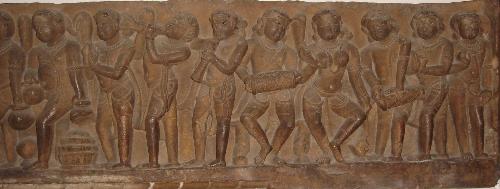
Introduction
Territorial
ideal of a one-State India
The Laws of War
Weapons of War as Gathered from Literature
Martial Arts - Fighting
without weapons
Army and Army Divisions
Aerial Warfare
Naval Warfare
Diplomacy and War
Conclusion
Articles
Images of Some Weapons

Introduction
The
value and importance of the army were realized very early in the history of
India, and this led in course of time to the maintenance of a permanent militia
to put down dissensions. War or no war, the army was to be maintained, to meet
any unexpected contingency. This gave rise to the Ksatriya or warrior
caste, and
the ksatram dharman came to mean the primary duty of war. To serve the country
by participating in war became the svadharma
or this warrior community.
 The
necessary education, drill, and discipline to cultivate militarism were confined
to the members of one community, the Ksatriyas. This prevented the militant
attitude from spreading to other communities and kept the whole social structure
unaffected by actual wars and war institutions. The
necessary education, drill, and discipline to cultivate militarism were confined
to the members of one community, the Ksatriyas. This prevented the militant
attitude from spreading to other communities and kept the whole social structure
unaffected by actual wars and war institutions.
(image source: War
in Ancient India - By V R Ramachandra Dikshitar).
Says the Arthva
Veda: "May
we revel, living a hundred winters, rich in heroes." The whole country
looked upon the members of the ksatriya community as defenders of their country
and consequently did not grudge the high influence and power wielded by the
Ksatriyas, who were assigned a social rank next in importance to the
intellectual and spiritual needs of the society. The ancient Hindus were a
sensitive people, and their heroes were instructed that they were defending the
noble cause of God, Crown and Country. Viewed in this light, war departments
were 'defense' departments and military expenditure were included in the cost of
defense. In this, as in many cases, ancient India was ahead of modern ideas.
Chivalry,
individual heroism, qualities of mercy and nobility of outlook even in the
grimmest of struggles were not unknown to the soldiers of ancient India. Thus
among the laws of war, we find that (1) a warrior (Khsatriya)
in armor must not fight with
one not so clad (2) one should fight only one enemy and cease fighting if the
opponent is disabled, (3) aged men, women and children, the retreating, or one
who held a straw in his lips as a sign of unconditional surrender should not be
killed. It is of topical interest to note that one of the laws enjoins the army
to leave the fruit and flower gardens, temples and other places of public
worship unmolested. Terence Duke,
author of The
Boddhisattva Warriors: The Origin, Inner Philosophy, History and Symbolism of
the Buddhist Martial Art Within India and China, martial arts went from India to China.
Fighting
without weapons was a specialty of the ancient Ksatreya warriors of India.
Top
of Page
Territorial
ideal of a one-State India
Imperial
sway in ancient India meant the active rule of an individual monarch who by his
ability and prowess brought to subjection the neighboring chieftains and other
rulers, and proclaimed himself the sole ruler of the earth. This goes by the
name of digvi-jaya. It is not necessary that he should conquer all States by the
sword. A small state might feel the weight of a conquering king and render
obeisance of its own accord.
According
to the Sangam classics, each of the
respective rulers of the chief Tamil kingdoms, the Cera, Cola and Pandya,
carried his sword as far north as the Himalayas, and implanted on its lofty
heights his respective crest the bow, the tiger and the fish. In these
adventures which the Tamil Kings underwent for their glorification, they did not
lag behind their northern brethren. The very epithet Imayavaramban
shows
that the limits of the empire under that Emperor extended to the Himalayas in
the north. This title was also earned by Ceran Senguttuvan by his meritorious
exploits in the north. Names like the Cola Pass in the Himalayan slopes, which
in very early times connected Nepal and Bhutan with ancient Tibet, give a
certain clue to the fact that once Tamil kings went so far north as the
Himalayas and left their indelible marks in those regions.

Kshatriya
Warrior - Now in Indian Museum, Calcutta.
(image
source: The Wonder that was India - By A L Basham
p. 100).
For
more refer to chapter on Greater
India: Suvarnabhumi and Sacred
Angkor
***
If
in the epic age a Rama and an Arjuna could come to the extremity of our
peninsula, and in the historical period of a Chandragupta or a Samudragupta
could undertake an expedition to this part of our country, nothing could prevent
a king of prowess and vast resources like the Cera king Senguttuvan from
carrying his armies to the north. The route lay through the Dakhan plateau, the
Kalinga, Malva, and the Ganga. Perhaps it was the ancient Daksinapatha
route
known to history from the epoch of the Rg Veda Samhita.
The
king who became conqueror of all India was entitled to the distinction of being
called a Samrat. In the Puranic period the great Kartavirya Arjuna of the
Haihaya clan spread his arms throughout the ancient Indian continent and earned
the title of Samrat.
The same principle of glory and distinction
underlay the performance of the sacrifice, Asvamedha and Rajasuya, which were
intended only for the members of the Ksatriya community.
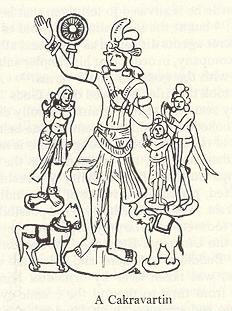 This
bears testimony to ' the existence of the territorial ideal of a one-State
India' (Cakravartiksetram of Kautalya). These kings were called Sarvabhaumas
and
Ekarats. This
bears testimony to ' the existence of the territorial ideal of a one-State
India' (Cakravartiksetram of Kautalya). These kings were called Sarvabhaumas
and
Ekarats.
Vedic
kings aimed at it, and epic rulers realized it. The idea of ekarat, continued
down to Buddhist times and even later. The Jatakas which are said to belong to
the fifth and sixth century B.C., make pointed reference to an all-Indian
empire. This concept of an all-India empire stretching from Kanyakumari to the
Himalayas, according to Kautalya receives further support from another important
political term: ekacchatra, or one-umbrella sovereignty.
(image
source: The Wonder that was India - By A L Basham
p. 84).
Hindus have
given shelter to the persecuted people from many lands and in all ages. But
what is most important, they have always regarded their own homeland as the only
playfield for their chakravartins, and never waged wars of conquest beyond the
borders of Bharata-varsha.
Top
of Page
The
Laws of War
When
society became organized and a warrior caste (Kshatriya) came into being, it was
felt that the members of this caste should be governed by certain humane laws,
the observance of which, it was believed, would take them to heaven, while their
non-observance would lead them into hell. In the post Vedic epoch, and
especially before the epics were reduced to writing, lawless war had been
supplanted, and a code had begun to govern the waging of wars. The ancient
law-givers, the reputed authors of the Dharmasutras
and the Dharmasastras, codified the then
existing customs and usages for the betterment of mankind. Thus the law books
and the epics contain special sections on royal duties and the duties of common
warriors.
It
is a general rule that kings were chosen from among the Kshatriya caste. In
other words, a non-Ksatriya was not qualified to be a king. And this is probably
due to the fact that the kshatriya caste was considered superior to others in
virtue of its material prowess. Though the warrior's code enjoins that all the
Ksatriyas should die on the field of battle, still in practice many died a
peaceful death. There is a definite ordinance of the ancient law books
prohibiting the warrior caste from taking to asceticism. Action and renunciation
is the watch-word of the Ksatriya. The warrior was not generally allowed to don
the robes of an ascetic. But Mahavira and Gautama
protested against these injunctions and inaugurated an order of monks or
sannyasins. When these dissenting sects gathered in strength and numbers, the
decline of Ksatriya valor set in. Once they were initiated into a life of peace
and prayer, they preferred it to the horrors of war. this was a disservice that
dissenting sects did to the cause of ancient India.
When
a conqueror felt that he was in a position to invade the foreigner's country, he
sent an ambassador with the message: 'Fight or submit.' More than 5000 years ago
India recognized that the person of the ambassador was inviolable. This
was a great service that ancient Hinduism rendered to the cause of international
law. It was the religious force that invested
the person of the herald or ambassador with an inviolable sanctity in the
ancient world. The Mahabharata rules
that the king who killed an envoy would sink into hell with all his
ministers.

The
Mahabharata War
Dharmayuddha is war carried on the principles of Dharma, meaning here the
Ksatradharma or the law of Kings and Warriors.
The Hindu laws of war
are very chivalrous and humane, and prohibit the slaying of the unarmed, of
women, of the old, and of the conquered.
Megasthenes noticed a peculiar
trait of Indian warfare they never ravage an enemy's land
with fire, nor cut down its trees.
(Artwork
courtesy of The Bhaktivedanta Book Trust International, Inc. www.krishna.com).
The
Bhagavad Gita has influenced great Americans from Thoreau to Oppenheimer. Its
message of letting go of the fruits of one’s actions is just as relevant today
as it was when it was first written more than two millennia ago.
***
As early as as
the 4th century B.C. Megasthenes noticed a
peculiar trait of Indian warfare.
"Whereas among other
nations it is usual, in the contests of war, to ravage the soil and thus to
reduce it to an uncultivated waste, among the Indians, on the contrary, by whom
husbandmen are regarded as a class that is sacred and inviolable, the tillers of
the soil, even when battle is raging in their neighborhood, are undisturbed by
any sense of danger, for the combatants on either side in waging the conflict
make carnage of each other, but allow those engaged in husbandry to remain quite
unmolested. Besides, they never ravage an enemy's land
with fire, nor cut down its trees."
(source: A
Brief History of India - By Alain Danielou p. 106). The modern "scorched
earth" policy was then unknown. "
Professor H.
H. Wilson says: "The Hindu laws of war
are very chivalrous and humane, and prohibit the slaying of the unarmed, of
women, of the old, and of the conquered."
At the very time when a battle was going on,
be says, the neighboring cultivators might be seen quietly pursuing their work,
- " perhaps ploughing, gathering for crops, pruning the trees, or reaping
the harvest." Chinese pilgrim to Nalanda
University, Hiuen Tsiang affirms that
although the there were enough of rivalries and wars in the 7th century A.D. the
country at large was little injured by them.
Top
of Page
Weapons of War as Gathered from Literature
Dhanur
Veda classifies the weapons of offence and defense into four - the
mukta, the amukta, the mukta-mukta and the yantramukta. The Nitiprakasika,
on the other hand, divides them into three broad classes, the mukta (thrown),
the amukta (not thrown), and the mantramukta (discharged by mantras). The bows
and arrows are the chief weapons of the mukta group. The very fact that our
military science named Dhanur Veda provides sufficiently clearly that the bow
and arrow were the principle weapons of war in those times. It was known by
different terms as sarnga, kodanda, and karmuka. Whether these are synonyms of
the same thing or were different is difficult to say. The Rg vedaic smith was
not only a steel worker but also an arrow maker.
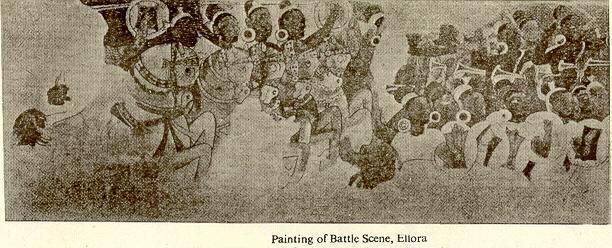
(image
source: War in Ancient India - By V R Ramachandra
Dikshitar).
***
Fire-Arms:
It would be interesting to
examine the true nature of the agneya-astras. Kautalya
describes agni-bana, and mentions three recipes - agni-dharana, ksepyo-agni-yoga,
and visvasaghati. Visvasaghati was composed
of 'the powder of all the metals as red as fire or the mixture of the powder of
kumbhi, lead, zinc, mixed with the charcoal and with oil wax and turpentine.'
From the nature of the ingredients of the different compositions it would appear
that they were highly inflammable and could not be easily extinguished.
A recent writer remarks: 'The Visvasaghati-agni-yoga was virtually a bomb which
burst and the fragments of metals were scattered in all directions. The
agni-bana was the fore-runner of a gun-shot.....
Sir A.
M. Eliot
tells us that the Arabs learnt the manufacture of gunpowder
from India, and that before their Indian connection they had used arrows of
naptha. It is also argued that though Persia possessed saltpetre in abundance,
the original home of gunpowder was India. It is said that the Turkish word top
and the Persian tupang or tufang are derived from the Sanskrit word dhupa. The
dhupa of the Agni Purana means a rocket,
perhaps a corruption of the Kautaliyan term natadipika.
(source: Fire-Arms in Ancient India - By Jogesh
Chandra Ray I.H.Q. viii. p. 586-88).
Heinrich
Brunnhofer (1841-1917), German Indologist, also believed that the
ancient Aryans of India knew about gunpowder.
(source: German
Indologists: Biographies of Scholars in Indian Studies writing in German
- By Valentine Stache-Rosen. p.92).
 Gustav
Oppert (1836-1908) born
in Hamburg, Germany, he taught Sanskrit and comparative linguistics at the
Presidency College, Madras for 21 years. He was the Telugu translator to the
Government and Curator, Government Oriental Manuscript Library. Translated Sukraniti,
statecraft by an unknown author. Gustav
Oppert (1836-1908) born
in Hamburg, Germany, he taught Sanskrit and comparative linguistics at the
Presidency College, Madras for 21 years. He was the Telugu translator to the
Government and Curator, Government Oriental Manuscript Library. Translated Sukraniti,
statecraft by an unknown author.
He attempted to prove that ancient Indians knew firearms.
(source: German
Indologists: Biographies of Scholars in Indian Studies writing in German
- By Valentine Stache-Rosen. p.81).
(For
more refer to article by G R Josyer - India:
The Home of Gunpowder and Firearms).
In his work,
Political Maxims of the Ancient Hindus, he says, that ancient India
was the original home of gunpowder and fire-arms. It is probable that the word
Sataghni referred to in the Sundara Kanda of the Ramayana refers to
cannon.
(source: Hindu
Culture and The Modern Age - By Dewan Bahadur K.S. Ramaswami Shastri
- Annamalai University 1956 p. 127).
The
word astra in the Sukraniti
is interpreted by Dr. Gustav Oppert as a bow. The term astra means a missile,
anything which is discharged. Agneya astra means a fiery arm as distinguished
from a firearm.
Dr.
Oppert refers to half a dozen temples in South India to prove the use of
fire-arms in ancient India. The Palni temple in the Madura District
contains on the outer portion in an ancient stone mantapa scenes of carved
figures of soldiers carrying in their hands small fire-arms, apparently the
small-sized guns mentioned in the Sukranitisara. Again in the Sarnagapani temple
at Kumbakonam in the front gate of the fifth story from the top is the
figure of
a king sitting in a chariot drawn by horses and surrounded by a number of
soldiers. Before this chariot march two sepoys with pistols in their
hands. In
the Nurrukkal mantapam of the Conjeevaram temple is a pillar on the north side
of the mandapa. Here is a relief vividly representing a flight between two
bodies of soldiers. Mounted horsemen are also seen. The foot-soldier is shown
aiming his fire-arm against the enemy. Such things are also noted in the Tanjore
temple and the temple at Perur, in the Coimbatore District. In the latter there
is an actual representation of a soldier loading a musket.
The Borobudar in Java where
Indian tradition is copied wholesale. They are ascribed roughly to the period
750-850 A.D. There is a striking relief series PL. I, fig. 5, (1605)
representing a battle in which two others are seen on each side, one wearing a
curved sword in the right hand and a long shield, and the other a mace and a
round shield resembling a wheel, all apparently made of iron. The story of the
Ramayana is also given as in the Tadpatri temple from Rama's going to the
forest down to the killing of Ravana. There is also a wonderful sculpture of an
ancient Hindu ship.
(source: Suvarnadvipa - By R.C.
Majumdar. pp 194-5).
Medhatithi
remarks thus "while fighting his enemies in battle, he shall not strike
with concealed weapons nor with arrows that are poisoned or barbed on with
flaming shafts."
Sukraniti
while referring to fire-arms, (agneyastras) says that
before any war, the duty of the minister of war is to check up the total stock
of gunpowder in the arsenal. Small guns is referred as tupak by Canda Baradayi.
The installation of yantras (engines of war) inside the walls of the forts
referred to by Manasollasa and the reference of Sataghni (killer of hundreds of
men) pressed into service for the protection of the forts by
Samaranganasutradhara clearly reveals the frequent use of fire arms in the
battle-field.
(source: India
Through The Ages: History, Art Culture and Religion - By G. Kuppuram
p. 512-513).
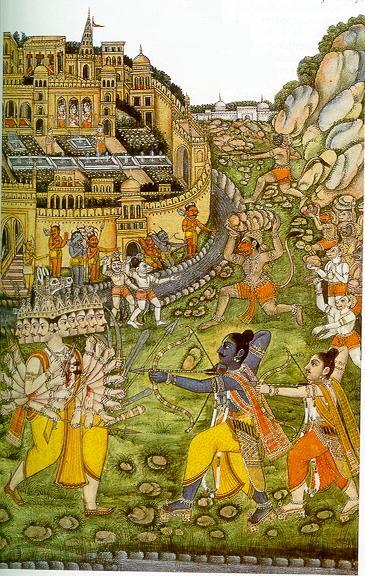
Lord Rama with his
bow defeats Ravana in the gold city of Lanka.
For
more refer to chapter on Greater
India: Suvarnabhumi and
Ethereal Prambanan and Sacred
Angkor
***
In the light of the above
remarks we can trace the evolution of fire-arms in the ancient India. There is
evidence to show that agni (fire) was praised for vanquishing an enemy. The
Arthava Veda shows the employment of fire-arms with lead shots. The Aitareya
Brahmana describes an arrow with fire at its tip. In the Mahabharata and
Ramayana, the employment of agnyastras is frequently mentioned, and this
deserves careful examination in the light of other important terms like ayah,
kanapa and tula-guda.
The agnicurna or gunpowder was composed of 4 to 6 parts of saltpetre, one part
of sulphur, and one part of charcoal of arka, sruhi and other trees burnt in a
pit and reduced to powder. Here is certain evidence of the ancient rockets
giving place to actual guns in warfare. From the description of the composition
of gunpowder, the composition of the Sukraniti
can be dated at the pre-Gupta age.
(source: War
in Ancient India - By V. R. Ramachandra Dikshitar 1944. p. 103 -105).
The 'Shukraniti'
medieval Indian text, describes how gun powder can be prepared using saltpetre,
sulphur and charcoal in different ratios for the use of different, types of guns.
Dr. Bedekar, who along with Dr R P Kulkarni authored a book Glimpses
of Chemistry in ancient and Medical India. Which was released
recently, had traced the origins of gunnery in
India
after almost eight months of through research.
Ancient text reveals that
while gunpowder was known as 'Agnicurna',
the guns were called 'Nalastra'.
One such combination of 'Agnicurna'
as stated in the text consists of five parts of saltpeter, one part of sulphur
and one part of charcoal to be dried in the sun. It is finally grinded into a
powder which becomes gun-powder.
'Shukraniti' suggests that
the 'Nalikas' are of two kinds, large and small - the smaller ones are 112.5 cms
long, have a stock of tough wood and a barrel of a bamboo with a bore of
three-fourth of an inch.
The small 'Nalikas' are
carried by infantry and cavalry. The larger 'Nalikas', has no wooden stock -
were made of steel and other metals ands was carried on wheels. The small shot
for smaller arms is made of lead or other metals, and the shots for larger guns
are made of iron.
For this the gunpowder is
composed of four, five or six parts of 'Suvarchi Lavana' (salt petre), one part
of sulphur and one part of Charcoal of plant arka (calotropis gigantea linn),
Snuhi and other trees burnt in a pit so as to exclude air.
The mixture is soaked in
sap of akra and rasuna (garlic), died in Sun and redacted to a coarse powder
like granulated sugar. that there are many kinds of 'Agnichurma' known to
experts, and they are composed of varied proportion of charcoal, sulphur, salt
petre, regular, orpiment, clax of lead, cinnabar, iron fillings, zinc dust,
shell -lac, blue vitriol and resin of pines to name a few. Some even give out
white light like that of moon.
(source: Evidence
of guns used in
Bengal
in 15th century - By Dr.
Vijay Bedekar - President of Thane-based Institute of Oriental Study).
Untold secrets - India
– the largest gunpowder source in the world
India’s military technology is history’s greatest ‘hidden’
secret. Official (and Western) portrayal
of Indian military systems in the face of Islamic invaders, Mughal sultanate
and the rise of British imperialism makes out India as a sitting duck with
ill-trained and terrified soldiers, armed with bows and arrows, who were
hopelessly outclassed by the enemy.
Facts being
otherwise, it raises questions about motives for this deliberate wrong
portrayal.
Modern history
credits China with the invention of gunpowder.
Firstly, this is largely based on the work of
a self-confessed
Sinophile
– Needham. With a
dismissive one
sentence,
Needham opines, “On Gunpowder history in India, Oppert (1) was duly exploded by
Hopkins(2).” And Indian history as the world’s largest
producer of gunpowder was swept under the carpet. Needham
conveniently ignores
evidence
like how;
"Jean
Baptiste Tavernier recorded a local tradition in the 1660s that
gunpowder and artillery were first invented in Assam from whence they spread to
China and he mentioned that the Mughal general who conquered Assam brought back
numerous old iron guns captured during the campaign."
Secondly,
Mongol territories extended from Mongolia to the gates
of Vienna and Russia – but not India. How is it that a few
deserters-soldiers could establish the world’s largest gunpowder production
system, so rapidly in non-Mongolian India. But, could not do so in conquered
territories of China, Central Asia, Middle East, West Asia, and Europe.
A 100 years
before Needham, India’s pioneering status in saltpetre was common knowledge.
English publications,
for instance in 1852
and another
in 1860 gave weightage
to the opinion of those who believe that gunpowder was invented in India and
brought by the Saracens from Africa to the Europeans; who improved its
manufacture and made it available for warlike purposes.
Unlike China,
with an odd textual reference or a drawing or a singular artefact, was the
entire industry in India – which remained unrivalled in the history of the
world. Compared to China’s paltry production of gunpowder, India’s widespread
and organized gunpowder production system points towards indigenous development.
There are
reports, that in
“664 an Indian visitor to China reportedly demonstrated the peculiar flamability
of saltpeter and provided instructions on how to locate it (Pacey 1990, 16).”
Tall
tales … thin stories
The deserter
Mongol soldier source seems rather far-fetched considering that Mongol armies
studiously avoided attacking India. India,
the richest economy
of the world
at
that time, known and famous for its wealth, was spared by Genghis Khan! Just why
would history’s foremost looter, invader, pillager spare India?
When Genghis
Khan’s Mongol armies were running rampant, Islamic refugees found shelter in
India, during the reign of Iltutmish. In 1221, Khwarezm-Shah and other Persian
refugees, sought refuge in India, across the Indus into the Punjab, India, from
Genghis Khan’s Mongol armies.
India – the largest gunpowder source in the world
Now, combine saltpetre production with the fact that the heart of the Indian
saltpetre production was in Bihar, which was also the home of the Nalanda
seminary /university.
India’s
gunpowder production system
India was the
largest gunpowder production system –
in the history of the world, till the 20th century. Specifically Bengal and
Bihar regions. Operated by a caste of
peoples called the nuniah, saltpetre
beds supplied the most vital element in gunpowder –
saltpetre. And India
produced virtually all of it.
Especially, Bihar, Bengal, Agra and Tamil Nadu, Andhra and Karanataka regions (Anantapur,
Coimbatore, Guntur, Kurnool). The Guntur Sircar
also manufactured saltpetre on a
commercial scale. A mid 17th century
Royal Society
paper documented
how saltpetre was made in India.
(source:
Indian gunpowder -
2ndlook.wordpress.com).
Bow and
Arrow:
In the words of H.
H. Wilson: "the Hindus cultivated archery most assiduously and
were very Parthians in the use of the bow on horse-back." One feature of
this weapon was that it could be handled by all the four classes of
warriors.
Vedic India had
honorable rules in Warfare.
"The Hindu laws of war are very chivalrous and humane, and prohibit the slaying
of the unarmed, of women, of the old, and of the conquered."
In contrast to
Islamic Onslaught and
European Imperialism
- no such laws were observed.
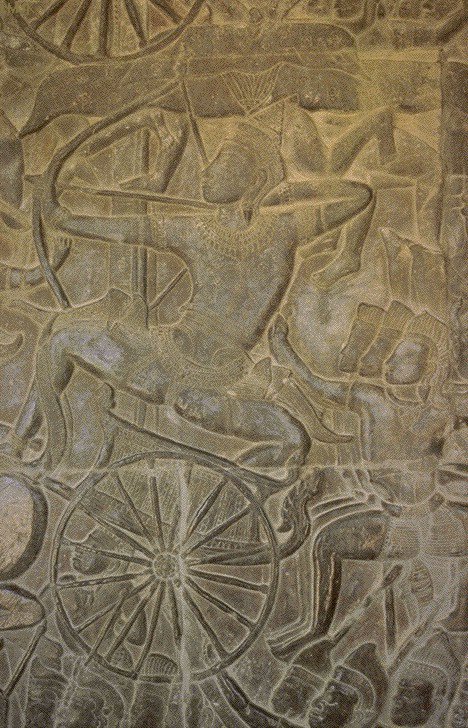
Frescos
on the Angkor Wat depict scenes from the Hindu epics Mahabharata and Ramayana,
showing Kshatriyas engaged in war.
For
more refer to chapter on Greater
India: Suvarnabhumi and
Ethereal Prambanan and Sacred
Angkor
***
Other
Weapons:
The Bindipala
and the nine following are minor weapons of this class. Probably this was a
heavy club which had a broad and bent tail end, measuring one cubit in length.
It was to be used with the left foot of the warrior placed in front. The various
uses of this weapon were cutting, hitting, striking and breaking. It was like a
kunta but with a big blade. It was used by the Asuras in their fight with
Kartavirya Arjuna.
The Nalika
is a hand gun or musket rightly piercing the mark. It was straight in form and
hollow inside. It discharged darts if ignited. As has been already said,
Sukracarya
speaks of two kinds of nalika, one big and the other small. The small
one, with a little hole at the end, measured sixty angulas (ie. distance
between the thumb and the little finger) dotted with several spots at the muzzle
end. Through the touch hole or at its breach which contained wood, fire was
conveyed to the charge. It was generally used by foot-soldiers. But the big gun
had no wood at the breach and was so heavy that it had to be conveyed in carts.
The balls were made of iron, lead or other material. Kamandaka uses the word
nalika in the sense of firing gun as a signal for the unwary king. Again
in the Naisadha, a work of the medieval
period, Damayanti is compared to the two bows of the god of love and goddess of
love, and her two nostrils to the two guns capable of throwing balls.
Thus there
is clear evidence of the existence and use of firing guns in India in very early
times.
The Cakra,
the next weapon in the category, is a circular disc with a small opening in the
middle. It was of three kinds of eight, six and four spokes. It was used in five
or six ways. It resembled the quoid of the Sikhs today. Lord Vishnu is popularly
addressed as Sankha-cakra-gada-pani, that is having Sankha or conch, Cakra or
disc, and Gada or mace in three of his four hands.The various uses of a
disc were felling, whirling, rending, breaking, severing, and cutting. It is one
of the instruments peculiar to Lord Vishnu. Kautalya speaks of it as a movable
machine. The Cakra belongs to the category of a
missile. According to the Vamanapurana, the Cakra has lustrous and sharp
edges.
The Tomara is another weapon of
war frequently mentioned in all kinds of warfare. It was of two kinds, an iron
club (sarvayasam) and a javelin. . According to the Agni Purana it was to be
with the help of an arrow of straight feathers, and was powerful in dealing
blows to the eyes and hands of an enemy.
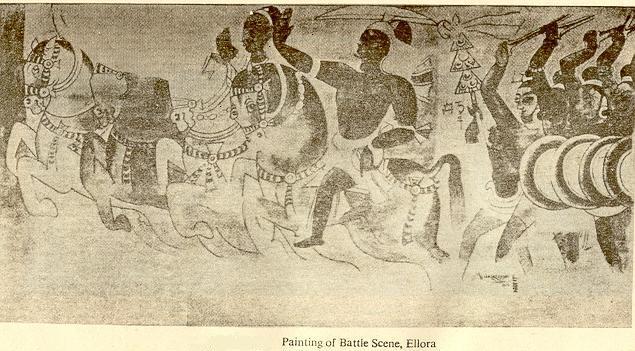
(image
source: War in Ancient India - By V R Ramachandra
Dikshitar).
Refer to
Shastar Vidya
***
The Dantakanta,
is another weapon of war, perhaps the shape of a tooth, made of metal, of strong
handle and a straight blade. It had two movements.
The Pasa,
which is a noose killing the enemy at one stroke, of two or tree ropes used as a
weapon attributed to the god Varuna. It was triangular in shape and embellished
with balls of lead. It was associated with three kinds of movements.
In the Agni Purana are described eleven ways of turning it to one's own
advantage by dexterity of hand.
The Masundi,
was probably an eight sided cudgel. It was furnished with a broad and strong
handle. It apparently comes from the root-meaning to cleave or break into
pieces, and perhaps akin to the Musala.
All these and more found used
in one battle or another both in the Mahabharata and the Ramayana.
Amukta
Weapons

(image
source: The Wonder that was India - By A L Basham).
***
The first of the Amukta weapons
was the Vajra or the thunderbolt. The origin
of this weapon is given in the Rirthayatra portion of the Mahabharata. It was
made out of the backbone of the Rishi Dadhici
which was freely given by him to Indra. Originally perhaps it had six sides and made
a terrible noise when hurled.
The
Parasu
is the battle-axe attributed to
Parasu-rama, of great fame. Its blade was made of steel and it had a wooden
handle. There were six ways of manipulating it to one's own advantage.
The Gada
is a heavy rod of iron with one hundred spikes on the top. One of the four
cubits was able to destroy elephants and rocks. It could be handled in twenty
different ways. By means of gun powder it could be used
as a projectile weapon of war. Its principal use was to strike the
enemy either from a raised place or from both sides and strike terror into the
enemy especially of the Gomutra array.
The Mudgara
was a staff in the shape of a hammer. It was used to break heavy stones and
rocks. This is again a movable machine according to Kautalya.
The Sira
was a bucket-like instrument curved on both sides and with a wide opening made
of iron. It was as long as a man's height. The Pattisa is
a razor like weapon.
The Sataghni,
literally means that which had the power of killing a hundred at a time. It
looked like a Gada and is said to be four cubits in length. It is generally
identified with modern cannon and hence was a projectile weapon of war.
"sataghni tu catustala
lohakantaka samcita yastih! iti Kesavah."
It was generally placed on the
walls of a fort and is included among the movable machines by Kautalya.
 Asi or
the Swords - The best sword measured fifty inches. They were usually
made of Pindara iron found in the Jangala country, black iron in the Anupa,
white iron in the Sataharana, gold colored in the Kalinga, oily iron in the
Kambhoja, blue-colored in Gujarat, grey-colored in the Maharashtra and reddish
white in Karnataka. The aSi si also known as Nistrimsa, Visamana, Khadga,
Tiksnadhara, Durasada, Srigarbha, Vijaya and Dharmamula, meaning respectively
cruel, fearful, powerful, fiery, unassailable, affording wealth, giving victory,
and the source of maintaining dharma. And these are generally the
characteristics of a sword. Asi or
the Swords - The best sword measured fifty inches. They were usually
made of Pindara iron found in the Jangala country, black iron in the Anupa,
white iron in the Sataharana, gold colored in the Kalinga, oily iron in the
Kambhoja, blue-colored in Gujarat, grey-colored in the Maharashtra and reddish
white in Karnataka. The aSi si also known as Nistrimsa, Visamana, Khadga,
Tiksnadhara, Durasada, Srigarbha, Vijaya and Dharmamula, meaning respectively
cruel, fearful, powerful, fiery, unassailable, affording wealth, giving victory,
and the source of maintaining dharma. And these are generally the
characteristics of a sword.
It was commonly worn on the
left side and was associated with thirty-two different movements. It measured 50
thumbs in length and four inches in width. In the Santi-parva
(166,3 ff; 82 ff). Bhisma being asked as to
which weapon in his opinion was the best for all kinds of fighting, replies that
the sword is the foremost among arms (agryah praharananam), but the bow is first
(adyam).
B, K,
Sarkar says that the secret of manufacturing the so-called Damascus
blade was learnt by the Saracens from the Persians, who, in their turn, had
learnt it from the Hindus. Early Arabic literature provides us with a curious
illustration of the esteem with which Indian swords were looked upon in Western
Asia. An early Arabic poet, Hellal, describing the flight of the Hemyarites,
says: "But they fled under its (ie. the clouds) small hail of arrows
quickly, whilst hard Indian swords were penetrating them." and again:
"He died and we inherited him; one old wide (cuirass) and a bright
Indian (sword) with a long shoulder-belt." (Hindu Achievements in Exact
Science - By B. K. Sarkar p. 45).
 (Note:
Hindus made the best swords in the ancient world, they discovered the process of
making Ukku steel, called Damascus steel by the rest of the world (Damas
meaning water to the Arabs, because of the watery designs on the blade).
These were the best swords in the ancient world, the strongest and the sharpest,
sharper even than Japanese katanas. Romans, Greeks, Arabs,
Persians, Turks, and Chinese imported it. The
original Damascus steel-the world's first high-carbon steel-was a product of
India known as wootz. Wootz is the English for ukku in Kannada and Telugu,
meaning steel. Indian steel was used for making swords and armor in
Persia and Arabia in ancient times. Ktesias at the court of Persia (5th c BC)
mentions two swords made of Indian steel which the Persian king presented him. The
pre-Islamic Arab word for sword is 'muhannad' meaning from Hind.
So famous were they that the Arabic word for sword was Hindvi - from Hind. (Note:
Hindus made the best swords in the ancient world, they discovered the process of
making Ukku steel, called Damascus steel by the rest of the world (Damas
meaning water to the Arabs, because of the watery designs on the blade).
These were the best swords in the ancient world, the strongest and the sharpest,
sharper even than Japanese katanas. Romans, Greeks, Arabs,
Persians, Turks, and Chinese imported it. The
original Damascus steel-the world's first high-carbon steel-was a product of
India known as wootz. Wootz is the English for ukku in Kannada and Telugu,
meaning steel. Indian steel was used for making swords and armor in
Persia and Arabia in ancient times. Ktesias at the court of Persia (5th c BC)
mentions two swords made of Indian steel which the Persian king presented him. The
pre-Islamic Arab word for sword is 'muhannad' meaning from Hind.
So famous were they that the Arabic word for sword was Hindvi - from Hind.
Wootz
was produced by carburising chips of wrought iron in a closed crucible process.
"Wrought iron, wood and carbonaceous matter was placed in a crucible and
heated in a current of hot air till the iron became red hot and plastic. It was
then allowed to cool very slowly (about 24 hours) until it absorbed a fixed
amount of carbon, generally 1.2 to 1.8 per cent," said eminent metallurgist
Prof. T.R. Anantharaman, who taught at Banares Hindu University, Varanasi.
"When forged into a blade, the carbides in the steel formed a visible
pattern on the surface." To the sixth century Arab poet Aus b. Hajr the
pattern appeared described 'as if it were the trail of small black ants that had
trekked over the steel while it was still soft'.
In
the early 1800s, Europeans tried their hand at reproducing wootz on an
industrial scale. Michael Faraday, the great experimenter and son of a
blacksmith, tried to duplicate the steel by alloying iron with a variety of
metals but failed. Some scientists were successful in forging wootz but they
still were not able to reproduce its characteristics, like the watery mark.
"Scientists believe that some other micro-addition went into it," said
Anantharaman. "That is why the separation of carbide takes place so
beautifully and geometrically."
The
crucible process could have originated in south India and the finest steel was
from the land of Cheras, said K. Rajan, associate professor of
archaeology at Tamil University, Thanjavur, who explored a 1st century AD trade
centre at Kodumanal near Coimbatore. Rajan's excavations revealed an industrial
economy at Kodumanal.
Pillar
of strength The rustless wonder called the Iron Pillar near the Qutb Minar at
Mehrauli in Delhi did not attract the attention of scientists till the second
quarter of the 19th century.
The
inscription refers to a ruler named Chandra, who had conquered the Vangas and
Vahlikas, and the breeze of whose valour still perfumed the southern ocean.
"The king who answers the description is none but Samudragupta, the real
founder of the Gupta empire," said Prof. T.R. Anantharaman, who has
authored The
Rustless Wonder. Zinc
metallurgy travelled from India to China and from there to Europe. As
late as 1735, professional chemists in Europe believed that zinc could not be
reduced to metal except in the presence of copper. The alchemical texts of the
mediaeval period show that the tradition was live in India.
In
1738, William Champion established the Bristol process to produce metallic zinc
in commercial quantities and got a patent for it. Interestingly, the mediaeval
alchemical text Rasaratnasamucchaya describes the same process, down to adding
1.5 per cent common salt to the ore.
(source: Saladin's
sword - By The
Week - June 24, 2001 - http://netinfo.hypermart.net/telingsteel.htm).
Artillery - India Taught Europe
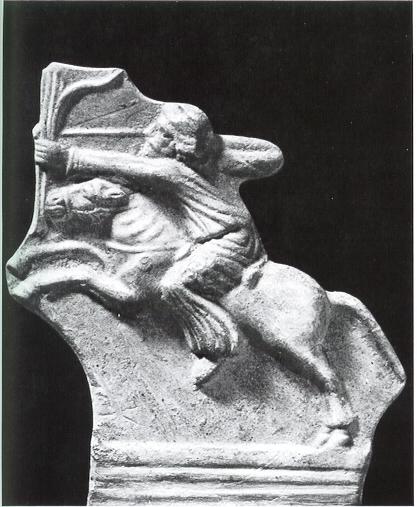 Artillery
was introduced into Europe by the Roma (Gyspsies), who were none else than the
Jats and Rajputs of India. Artillery
was introduced into Europe by the Roma (Gyspsies), who were none else than the
Jats and Rajputs of India.
This has been revealed in a study by a reputed linguist, Weer
Rajendra Rishi, after an extensive tour of Roma camps in Europe.
He explains that the Romas, who are the Gypsies of Europe,
also taught the use of artillery to Europeans. These Roma belonged to the Jat
and Rajput clans who left India during the invasions by Mohamud Ghaznavi and
Mohammad Ghori between the 10th and 12th centuries of the
Christian era.
(image
source: India: A concise history - By Francis Watson
p. 55).
He says the use of artillery was known in Asia, notably in
India, from time immemorial, while it was introduced to the Europeans much
later.
Mr. Rishi reveals that the Roma had helped different
countries of Europe in making artillery. “Evidence of this is given as early
as 1496 by a mandate of that date granted by Wadislas, King of Hungary, wherein
it is said that Thomas Polgar, chief of 25 tents of wandering Gypsies had, with
his people, made at Funfkirchen musket-balls and other ammunition for Bishop
Sigismond. “In 1546 when the English were holding Boulogne against the French
the latter took the help of two experienced Romas of Hungary to make great
number of cannons of greater caliber than earlier guns. The Hungarian Roma of
the 16th century possessed fuller knowledge of fabricating artillery
than the races of Western Europe.
There were also records that the Roma were employed as
soldiers by some countries of Europe. Dr. W. R. Rishi, is the author of the book, Roma - The Panjabi Emigrants in
Europe, Central and Middle Asia, the USSR, and the Americas - published 1976.
Mr. Rishi is a well-known linguist of India and was awarded the honour of 'Padmashri'
by the President of India in 1970 for his contributions in the field of
linguistics. He is also the Founder
Director of the Indian Institute of Romani Studies.
(source:
Diamonds, Mechanism, Weapons of War, Yoga Sutras - By
G. R. Josyer. p. 179-182).
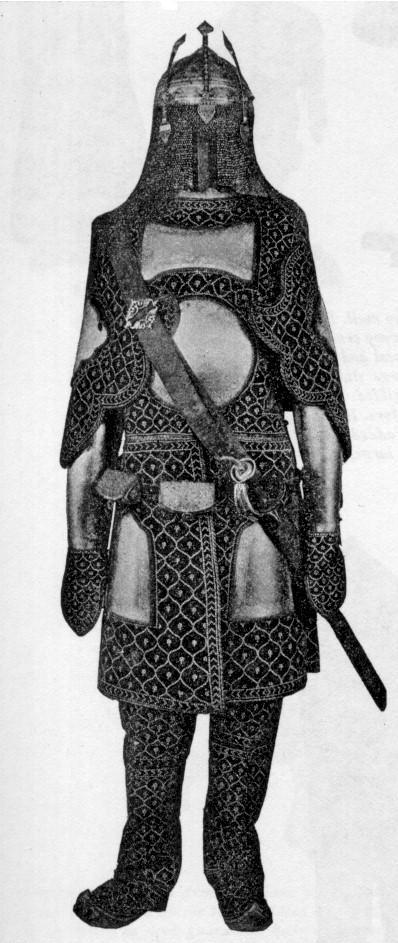
Indian Armour
To conclude with the words of
Sir George Birdwood:
" For a
variety, extent, and gorgeousness, and ethnological and artistic value, no such
collection of Indian arms exists in this country (England) as that belonging to
the Prince of Wales. It represents the armorer's art in every province of India,
from the rude spear of the savage Nicobar islanders to the costly damascened,
sculptured, and jewelled swords, and shields, spears, daggers, and match-locks
of Kashmir, Kutch and Vizianagaram. The most striking object in the collection
is a suit of armor made entirely of the horny scales of the Indian armadillo, or
pangolin, encrusted with gold, and turquoise, and garnets."
(source:
The Industrial Arts of India pp. 171-2).
Top
of Page
Martial
Arts - Fighting without weapons
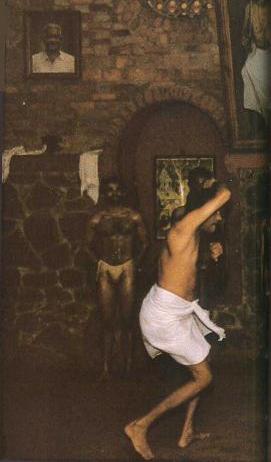 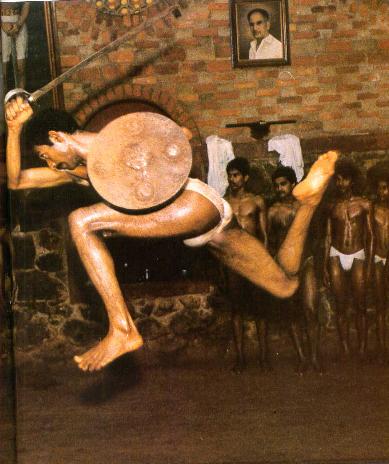
"Fighting
without weapons was a specialty of the Ksatreya (caste of Ancient India) and foot
soldier alike.
Danger and Divinity:
Originating at least 1,300 years ago, India's Kalaripayit is the oldest martial
art taught today. It is also one of the most potentially violent. Weaponless but
nimble, a karaipayit master displays for his students how to meet the attack of
an armed opponent.
For
more refer to chapter on Greater
India: Suvarnabhumi and Sacred
Angkor
Watch
Kalari
Martial Arts and
Silambam
Martial Arts video and
Shastar Vidya
***
"Fighting
without weapons was a specialty of the Ksatreya (caste of Ancient India)and foot
soldier alike. For the Ksatreya it was simply part and parcel of their all
around training, but for the lowly peasant it was essential. We read in the
Vedas of men unable to afford armor who bound their heads with turbans called Usnisa
to protect themselves from sword and axe blows.
"Fighting on foot for a Ksatreya was necessary in case he was unseated from his
chariot or horse and found himself without weapons. Although the high ethical
code of the Ksatreya forbid anyone but another Ksatreya from attacking him,
doubtless such morals were not always observed, and when faced with an
unscrupulous opponent, the Ksatreya needed to be able to defend himself, and
developed, therefore, a very effective form of hand-to-hand combat that combined
techniques of wrestling, throws, and hand strikes. Tactics and evasion were
formulated that were later passed on to successive generations. This skill was
called Vajramukhti, a name meaning "thunderbolt closed - or clasped -
hands." The tile Vajramukti referred to the usage of the hands in a manner
as powerful as the vajra maces of traditional warfare. Vajramukti was practiced
in peacetime by means of regular physical training sessions and these utilized
sequences of attack and defense technically termed in Sanskrit nata."
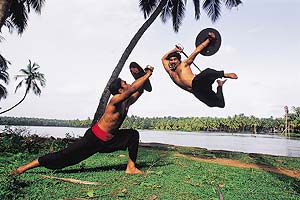 Kalaripayattu,
literally “the way of the battlefield,” still survives in Kerala,
where it is often dedicated to Mahakali. The Kalari grounds are usually situated
near a temple, and the pupils, after having touched the feet of the master,
salute the ancestors and bow down to the Goddess, begin the lesson. Kalari
trainings have been codified for over 3000 years and nothing much has changed. Kalaripayattu,
literally “the way of the battlefield,” still survives in Kerala,
where it is often dedicated to Mahakali. The Kalari grounds are usually situated
near a temple, and the pupils, after having touched the feet of the master,
salute the ancestors and bow down to the Goddess, begin the lesson. Kalari
trainings have been codified for over 3000 years and nothing much has changed.
The warming up is essential and
demands great suppleness. Each movement is repeated several times, facing north,
east, south and west, till perfect loosening is achieved. The young pupils pass
on to the handling of weapons, starting with the “Silambam”, a short stick made of extremely hard wood, which in the olden times could
effectively deal with swords. The blows are hard and the parade must be fast and
precise, to avoid being hit on the fingers! They continue with the swords,
heavy, and dangerous, even though they are not sharpened any more, as they are
used. Without guard or any kind of body protection; they whirl, jump and parry,
in an impressive ballet. Young, fearless girls fight with enormous knives,
bigger than their arms and the clash of irons is echoed in the ground. The
session ends with the big canes, favorite weapons of the Buddhist traveler
monks, which they used during their long journey towards China to scare away
attackers.
The
“Urimi” is the most extraordinary weapon of Kalari, unique in the world.
This double-edged flexible sword which the old-time masters used to wrap around
the waist to keep coiled in one hand, to suddenly whip at the opponent and
inflict mortal blows, is hardly used today in trainings, for it is
much too dangerous.
This indigenous martial arts, under the name of Kalari
or Kalaripayit exists only in South India today. Kalarippayat
is said to be the world's original martial art. Originating at least 1,300 years ago, India's
Kalaripayit is the oldest martial art taught today. It is also the most
potentially violent, because students advance from unarmed combat to the use of
swords, sharpened flexible metal lashes, and peculiar three-bladed daggers. More
than 2,000 years old, it was developed by warriors of the Cheras kingdom in
Kerala. Training followed strict rituals and guidelines. The entrance to the 14
m-by-7 m arena, or kalari, faced east and had a bare earth floor. Fighters took
Shiva and Shakti, the god and goddess of power, as their deities. From unarmed
kicks and punches, kalarippayat warriors would graduate to sticks, swords,
spears and daggers and study the marmas—the 107 vital spots on the human body
where a blow can kill. Training was conducted in secret, the lethal warriors
unleashed as a surprise weapon against the enemies of Cheras.
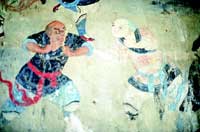 Father
and founder of Zen Buddhism (called C’han in China), Boddidharma, a Brahmin
born in Kacheepuram in Tamil Nadu, in 522 A.D. arrived at the courts of the
Chinese Emperor Liang Nuti, of the 6th dynasty. He taught the Chinese monks
Kalaripayattu, a very ancient Indian martial art, so that they could defend
themselves against the frequent attacks of bandits. In time, the monks became
famous all over China as experts in bare-handed fighting, later known as the
Shaolin boxing art. The Shaolin
temple which has been handed back a few years ago by the communist
Government to the C’han Buddhist monks, inheritors of Boddhidharma’s
spiritual and martial teachings, by the present Chinese Government, is now open
to visitors. On one of the walls, a fresco can be seen, showing Indian
dark-skinned monks, teaching their lighter-skinned Chinese brothers the art of
bare-handed fighting. On this painting are inscribed: “Tenjiku Naranokaku”
which means: “the fighting techniques to train the
body (which come) from India…” Father
and founder of Zen Buddhism (called C’han in China), Boddidharma, a Brahmin
born in Kacheepuram in Tamil Nadu, in 522 A.D. arrived at the courts of the
Chinese Emperor Liang Nuti, of the 6th dynasty. He taught the Chinese monks
Kalaripayattu, a very ancient Indian martial art, so that they could defend
themselves against the frequent attacks of bandits. In time, the monks became
famous all over China as experts in bare-handed fighting, later known as the
Shaolin boxing art. The Shaolin
temple which has been handed back a few years ago by the communist
Government to the C’han Buddhist monks, inheritors of Boddhidharma’s
spiritual and martial teachings, by the present Chinese Government, is now open
to visitors. On one of the walls, a fresco can be seen, showing Indian
dark-skinned monks, teaching their lighter-skinned Chinese brothers the art of
bare-handed fighting. On this painting are inscribed: “Tenjiku Naranokaku”
which means: “the fighting techniques to train the
body (which come) from India…”
Kalari
payatt was banned by the British in 1793.
Refer
to chapter on European Imperialism.
Watch
Kalari
Martial Arts and
Silambam
Martial Arts video
(For
more information on martial arts refer to chapter India
and China and Kalarippayattu
and
Kalari
Payatte - The martial art of Kerala
(source: The
Boddhisattva Warriors: The Origin, Inner Philosophy, History and Symbolism of
the Buddhist Martial Art Within India and China - By Terence Dukes/ Shifu Nagaboshi Tomio
p. 3
- 158-174 and 242. A
Western Journalist on India: a ferengi's columns - By Francois Gautier
Har-Anand Publications January 2001 ISBN 8124107955 p. 155-158).
Silambam – Indian Stick Fighting

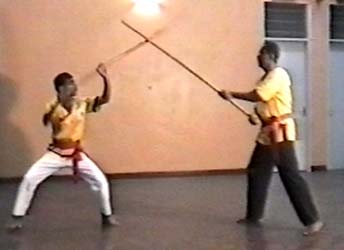
The
art Nillaikalakki Silambam was brought to
the royal court during the reign of the Cheran, Cholan and Pandian emperors,
once powerful rulers of India.
Watch
Kalari
Martial Arts and
Silambam
Martial Arts video and
Shastar Vidya
***
The
art Nillaikalakki Silambam,
which exists for more than five thousand years,
is an authentic art which starts with the stick called Silambamboo (1.68 meters
long). It originates from the Krunji
mountains of south India, and is as old as the Indian sub-continent itself.
The natives called
Narikuravar were using a staff called Silambamboo as a weapon to defend
themselves against wild animals, and also to display their skill during their
religious festivals. The Hindu scholars and yogis who went to the Krunji
mountains to meditate got attracted by the display of this highly skilled
spinning Silambamboo. The
art Nillaikalakki Silambam therefore became a part of the Hindu scholars and
yogis training, as they were taught by the Narikuravar.
They brought the art to
the royal court during the reign of the Cheran, Cholan and Pandian emperors,
once powerful rulers of India.
(source: Silamban
– Indian Stick Fighting).
Top
of Page
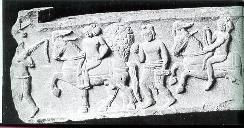 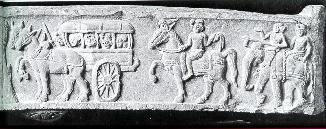
(image
source: India: A concise history - By Francis Watson
p. 60).
***
Army
and Army Divisions
The Game of
Chess and the Four-Fold Force
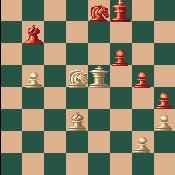 Owing to peculiar geographical
features, with her vast plains interspersed with forests, the ancient Indian
States had to make extensive use of mounted forces which comprised cavalry,
chariots, and elephants. This does not mean that infantry was neglected. Owing to peculiar geographical
features, with her vast plains interspersed with forests, the ancient Indian
States had to make extensive use of mounted forces which comprised cavalry,
chariots, and elephants. This does not mean that infantry was neglected.
Hindu
India possessed the classical fourfold force of chariots, elephants, horsemen,
and infantry, collectively known as the Caturangabala.
Students also know that the old game of chess also goes by the name of Caturanga.
Chess is a game of war, and in each game there are a king, a councilor, two
elephants, two horses, two chariots, and eight foot-soldiers. From the
references to this game in the Rg Veda and the Atharva Veda and in the Buddhists
and Jaina books, it must have been very popular in ancient India. The Persian
term Chatrang and the Arabic Shatrang are forms of the Sanskrit Chaturanga.
The famous epic Mahabharata
narrates an incidence where a game called Chaturang was played between two
groups of warring cousins. In some form or the other, the game
continued till it evolved into chess. H. J. R. Murray, in his work titled “A
History of Chess”, has concluded that “chess is a descendant of an Indian
game played in the 7th century AD”. The Encyclopedia
Britannica states that “we find the best authorities agreeing that
chess existed in India before it is known to have been played anywhere else.”
(For more on chess refer to
chapter on Hindu Culture).
On the whole the board is 8 X 8
squares. According to Taylor, the game of chess was the invention of some Hindu
who devised a game of war with the astapada board as his field of battle. From
the reference to the game in the Rig Veda and the Arthava Veda and in the
Buddhist and Jaina books, it must have been very popular in ancient India. It is
to be noted that the relative values of the chess pieces were analogous to or
identical with the relative values of different arms as laid down by Kautalya,
Sukra, and Vaisampayana. The organization of the Indian army which
came to be known as Caturanga, both in epic Sanskrit and Pali literature, was
based on the ancient game.
The
Chariots: Chariots were used in warfare from very remote times. There
are many references to chariots in the Samhitas and in the Brahmanas. The
chariot was an indispensable instrument of war in the days of the Vedas, and on
its possession depended victory. In the Rg Veda there is a hymn addressed to the
war chariot: ' Lord of the wood, be firm and strong in body: be bearing as a
brave victorious hero. Show forth thy strength, compact with straps of leather
and let thy rider win all spoils of battle.' Chariots were of different types
and materials. In the Ramayana and the Mahabharata their use is largely in
evidence. Each chariot was marked off by its ensign and banner. Besides flags,
umbrellas (chattra, atapatra), and fans were a part of the paraphernalia of the
war chariot. Sukra mentions an awe-inspiring chariot of
iron with swift-moving wheels, provided with good seats for the warriors and a
seat in the middle for the charioteer; the chariot was also equipped with all
kinds of offensive and defensive weapons.

Warrior
Arjuna with Krishna - driving the chariot in the epic The Mahabharata.
The
Bhagavad Gita has influenced great Americans from Thoreau to Oppenheimer. Its
message of letting go of the fruits of one’s actions is just as relevant today
as it was when it was first written more than two millennia ago.
***
The
conception of the sun-god in Indian tales is of value to the student of ancient
Indian military history. The idea is that the sun-god wants to destroy darkness.
Therefore he dons a lustrous armor and marching in his swift flying chariot
drawn by seven powerful steads, Aruna (dawn) being his charioteer. The whole
image presents a life-like portrait of the military dress as well as the march
against an enemy.
Elephants: The
next important force of war consisted of elephants. The numerous representations
of the animal on coins and in architectural sculptural works from Gandhara to
Ramesvaram as well as bronze figures in Indonesia are an indication of the
esteem in which it was held by the ancient Indians, clearly on account of its
usefulness.

An Elephant
Armour: An important force of war consisted of elephants.
***
There is a reference in the Rg Veda to two elephants bending their
heads and rushing together against the enemy, which is a fairly early reference
to the animal being used in war. By the time of the Yajur Veda Samhita the art
of training elephants had become common. The Arthasastra mentions a special
officer of the State for the care of elephants and lays down his duties.
Megasthenes explains how the elephants were hunted, and how their distempers
were cured by simple remedies such as cow's milk for eye-disease and pig's fat
for sores. A Jataka story throws some light on how
fire-weapons were used in ancient India. "Once a king mounted on
an elephant and led an attack on the city of Benares. The soldiers who offered
defences from within the city gates discharged a shower of missiles against the
enemy at which the elephant was frightened a little." The use of burning
naphtha balls thrown against on rushing elephants to frighten them and make them
turn back on their own side, is mentioned by early Mohammadan historians as a
feature of the warfare between the Rajputs and the Turkish invaders from the
North-West. (Elliot and Dowson, vol. I).
Cavalry:
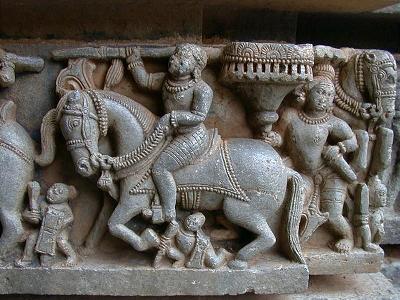
We
hear from the Kautaliya and Megasthenes that there was a well-organized and
efficient cavalry force in the army of Chandragupta. In the ArthaVeda we hear of
dust-raising horsemen.
For
more refer to chapter on Greater
India: Suvarnabhumi and Sacred
Angkor
***
We
hear from the Kautaliya and Megasthenes that there was a well-organized and
efficient cavalry force in the army of Chandragupta. In the ArthaVeda we hear of
dust-raising horsemen. In this connection it is interesting to consider the
oft-repeated statement that horses are non-Indian. It is not the whole truth.
They were known to the Asuras of Vedic literature. There is a legend narrated in
the third book of the Hariharacaturanga (though this is work of the late 12th
century A.D., the tradition recorded is very ancient). In the epoch of the epics
and the Arthasastra, we find that the cavalry occupied as important a place in
the army as any other division.
Megasthenes corroborates the
evidence of the Arthasastra. There was a special department in the State for the
cavalry. The horses of the State were provided with stables and placed under the
care of good grooms and syces. There were several trained horsemen who could
jump forward and arrest the speed of galloping horses. But the majority of them
rode their horses with bit and bridle. When horses became ungovernable they were
placed in the hands of professional trainers who made the animals gallop round
in small circles. In selecting horses of war, their age, strength, and size were
taken into account. We may remark in passing that Abhimanyu's horses were only
three years old.
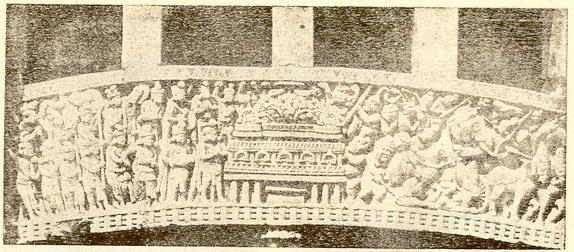
(image
source: War in Ancient India - By V R Ramachandra
Dikshitar).
***
How important the science of
horses was to the ancient Indians is best seen from the Laksanaprakasa
which quotes from several important old authorities some of which are probably
lost to us. Among them are the Asvayurveda and Asvasastra, the former attributed
to Jayadeva and the latter to Nakula. Both the Puranas
and the epics agree that the horses of the Sindhu and Kamboja regions were the
finest breed and that the services of the Kambojas as cavalry troopers were
requisitioned in ancient wars. In the Mahabharata war the Kambojans (Cambodians)
were enlisted. The steeds of Bahalika were also highly esteemed.
Horses had names and so did elephants. Unlike the chariot horse, the cavalryman
drove his animal with a whip which was generally fixed to the wrist. This
allowed his hand free play. The cavalryman was armed with arrow or spear or
sword. He wore breastplate and turban (unsnisa). Worth noting is the fact that
horses were made to drink wine before actually marching to battle.
The tactical use of the cavalry
was to break through the obstacles on the way, to pursue the retreating enemy,
to cover the flanks of the army, to effect speedy communication with the various
parts of the army unobserved (bahutsara) and to pierce the enemy ranks from the
front to the rear. The cavalry was responsible, in a large measure, for the
safety and security of the army in entrenched positions, forests or camps. It
obstructed movements of supplies and reinforcements to the enemy. In short, the
cavalry was indispensable in situations requiring quickness of movement.
Infantry:
The next important division of
the army was the infantry, or foot-soldier. The Arthasastra speaks of the
infantry as a separate army department under the charge of a special officer of
the State. This receives confirmation from Megasthenes statement. Besides the
maula or hereditary troops which formed a considerable portion of the army,
there were the bhrta or mercenaries, the sreni or soldiers supplied by the
different group and guild organizations, the mitra or soldiers supplied by
allies, the amitra or deserters from the enemy ranks, and the atavi recruited
from forest tribes. According to the Sukraniti and the Kamandakanitsara, the
army was to be made as imposing as possible to frighten the enemy by its size.
The Agni-purana says that victory ever attends the army where foot-soldiers are
numerically strong.
The
Sukraniti also mentions that foot-soldiers possessed fire-arms when they
fought.
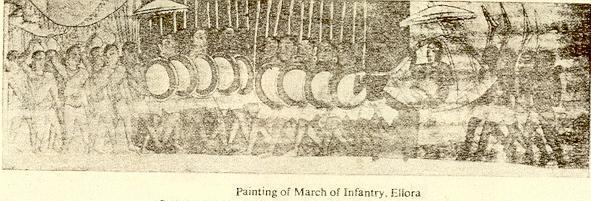
(image
source: War in Ancient India - By V R Ramachandra
Dikshitar).
***
When these foot-soldiers
equipped themselves for war Arrian says
that 'they carry a bow made of equal length with the
man who bears it. This they rest upon the ground and pressing against it and
their left foot, thus discharge the arrow having drawn the string backwards: the
shaft they use is little short of being three yards long, and there is nothing
which can resist an Indian Archer's shot - neither shield nor breast-plate, nor
any stronger defense if such there be.' In their left hand they carry
bucklers made of undressed ox-hide which are not so broad as those who carry
them but are about as long. If we turn to the ancient nations and especially the
ancient Egyptians we meet with almost a similar description.
The Commissariat:
 The
Caturanaga was a classical
division of the army accepted by tradition. But in the epoch of the epic we hear
of a Sadanga or the six-fold army, including commissariat and admiralty. The use
of commissariat can be traced to the epic age. This belonged to the category of
administrative division of troops as against the combatant. We are told that
this division of the army into two categories was first seen in the battle of
Mansikert (1071 A.D.) The
Caturanaga was a classical
division of the army accepted by tradition. But in the epoch of the epic we hear
of a Sadanga or the six-fold army, including commissariat and admiralty. The use
of commissariat can be traced to the epic age. This belonged to the category of
administrative division of troops as against the combatant. We are told that
this division of the army into two categories was first seen in the battle of
Mansikert (1071 A.D.)
But, centuries before, the Indian army leaders had realized the value of such a
division. It is said that when the Pandava army marched to Kurukshetra it was
followed by 'carts and transport cars, and all descriptions of vehicles, the
treasury, weapons and machines and physicians and surgeons, along with the few
invalids that were in the army and all those that were weak and powerless. This
was purely a civil department attached to the army. Care was also given to
wounded animals.
The numerous references in our
authorities to the Commissariat demonstrate beyond doubt that wars were planned
methodically and conducted systematically.
The Admiralty:
The Admiralty as a department
of the State may have been a creation of Chandragupta but there is evidence to
show that the use of ships and boats was known to the people of the Rig
Veda. In the following passage we have reference to a vessel with a
hundred oars. 'this exploit you achieved, Asvins in the ocean, where there is
nothing to give support, nothing to rest upon, nothing to cling to, that you
brought Bhujya, sailing in a hundred-cared ship, to his father's house."
(refer to Naval warfare section).
Cartography
There
is no special word in Sanskrit for a 'a map.' There is, however, reason to
believe that in ancient India a map or chart was regarded as a citra or alekhya,
i.e., 'a painting, a picture, a delineation'. That maps were made in
ancient India seems to be quite clear from the evidence of the New History of
the T'ang Dynasty which gives an account of the Chinese general Wang Hiuen-tse's
exploits in India in the year 648 A.D.
With
reference to the knowledge of map-making among the people of India, especially
the Dravidians of the South:
"The
charts in use by the medieval navigators of the Indian Ocean - Dravidas, Arabs,
Persians, were equal in value, if not superior, to the charts of the
Mediterranean. Marco Polo (1498) found them in the hands of his Indian pilot,
and their nature is fully explained in the Mohit or 'the Encyclopaedia of the
Sea',
**
Hindu Valor
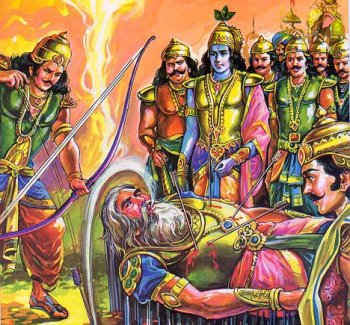 The Hindus were declared the by
the Greeks to be the bravest nation they ever came in contact with. (source: History
of India - by Mountstuart Elphinstone p. 197). The Hindus were declared the by
the Greeks to be the bravest nation they ever came in contact with. (source: History
of India - by Mountstuart Elphinstone p. 197).
It
was the Hindu King of Magadha that struck terror in the ever-victorious armies
of Alexander.
Abul
Fazal, the minister of Akbar, after admiring their noble virtues,
speaks of the valor of the Hindus in these terms: “Their character shines
brightest in adversity. Their soldiers (Rajputs) know to what it is to flee from
the fields of battle, but when the success of the combat becomes doubtful, they
dismount from their horses and throw away their lives in payment of the debt of
valor.”
Francois
Bernier, A 17th century traveler says that: “The Rajputs embrace
each other when on the battlefields as if resolved to die.” The Spartans, as
is well known, dressed their hair on such occasions. It is well known that when
a Rajput becomes desperate, he puts on garments of saffron
color, which act, in technical language, is called kesrian
kasumal karna (donning saffron robes).
(source:
Hindu Superiority - By Har Bilas Sarda p. 79
- 91).
Top
of Page
Aerial Warfare
 “The ancient Hindus could
navigate the air, and not only navigate it, but fight battles in it like so many
war-eagles combating for the domination of the clouds. To be so perfect in
aeronautics, they must have known all the arts and sciences related to the
science, including the strata and currents of the atmosphere, the relative
temperature, humidity, density and specific gravity of the various gases...” “The ancient Hindus could
navigate the air, and not only navigate it, but fight battles in it like so many
war-eagles combating for the domination of the clouds. To be so perfect in
aeronautics, they must have known all the arts and sciences related to the
science, including the strata and currents of the atmosphere, the relative
temperature, humidity, density and specific gravity of the various gases...”
~ Col. Henry S Olcott (1832 – 1907) American
author, attorney, philosopher, and cofounder of the Theosophical
Society in a lecture in Allahabad, in 1881.
***
No question can be more interesting in the present
circumstances of the world than India’s contribution to the science of
aeronautics. There are numerous illustration in our vast Puranic and epic
literature to show how well and wonderfully the ancient Indians conquered the
air. To glibly characterize everything found in this literature as imaginary and
summarily dismiss it as unreal has been the practice of both Western and Eastern
scholars until very recently. The very idea indeed was ridiculed and people went
so far to assert that it was physically impossible for man to use flying
machines. But today what with balloons, airplanes…..”
Turning to Vedic literature, in one of the Brahmanas occurs
the concept of a ship that sails heavenwards. The ship is the Agnihotra of which
the Ahavaniya and Garhapatya fires represent the two sides bound heavenward, and
the steersman is the Agnihotrin who offers milk to the three Agnis. Again in the
still earlier Rg Veda Samhita we read that the Asvins conveyed the rescued
Bhujya safely by means of winged ships. The latter may refer to the aerial
navigation in the earliest times.
In the recently published Samarangana Sutradhara of Bhoja, a
whole chapter of about 230 stanzas is devoted to the principles of construction
underlying the various flying machines and other engines used for military and
other purposes.
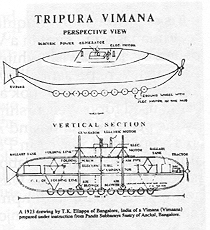

The ancient Hindus could
navigate the air, and not only navigate it, but fight battles in it like so many
war-eagles combating for the domination of the clouds.
(image
source: Vymaanika
Shaastra Aeronautics of Maharshi Bharadwaaja - By G. R. Josyer).
***
The various advantages of using machines, especially flying
ones, are given elaborately. Special mention is made of their use at one’s
will and pleasure, of their uninterrupted movements, of their strength and
durability, in short of their capability to do in the air all that is done on
earth. Three movements are usually ascribed to these machines, - ascending,
cruising thousands of miles in different directions in the atmosphere and lastly
descending. It is said that in an aerial car one can mount up to Suryamandala,
‘solar region’ and the Naksatra mandala (stellar region) and also travel
throughout the regions of air above the sea and the earth. These cars are said
to move so fast as to make a noise that could be heard faintly from the ground.
The evidence in its favor is overwhelming.
An aerial car is made of light, wood looking like a great
bird with a durable and well-formed body having mercury inside and fire at the
bottom. It had two resplendent wings, and is propelled by air. It flies in the
atmospheric regions for a great distance and carries several persons along with
it. The inside construction resembles heaven created by Brahma himself. Iron,
copper, lead and other metals are also used for these machines. All these show
how far art and science was developed in ancient India in this direction. Such
elaborate description ought to meet the criticism that the vimanas and similar
aerial vehicles mentioned in ancient Indian literature should be relegated to
the region of myth.
The ancient writers could certainly make a distinction
between the mythical which they designated as daiva and the actual aerial wars
designated as manusa.
 After the great victory of Rama over Lanka, Vibhisana
presented him with the Puspaka vimana which was furnished with windows,
apartments, and excellent seats. It was capable of accommodating all the vanaras
besides Rama, Sita and Lakshman. Again in the Vikramaurvaisya, we are told that
king Puraravas rode in an aerial car to rescue Urvasi in pursuit of the Danava
who was carrying her away. Similarly in the Uttararamacarita in the flight
between Lava and Candraketu (Act VI) a number of aerial cars are mentioned as
bearing celestial spectators. There is a statement in the Harsacarita of Yavanas
being acquainted with aerial machines. The Tamil work Jivakacintamani refers to
Jivaka flying through the air. After the great victory of Rama over Lanka, Vibhisana
presented him with the Puspaka vimana which was furnished with windows,
apartments, and excellent seats. It was capable of accommodating all the vanaras
besides Rama, Sita and Lakshman. Again in the Vikramaurvaisya, we are told that
king Puraravas rode in an aerial car to rescue Urvasi in pursuit of the Danava
who was carrying her away. Similarly in the Uttararamacarita in the flight
between Lava and Candraketu (Act VI) a number of aerial cars are mentioned as
bearing celestial spectators. There is a statement in the Harsacarita of Yavanas
being acquainted with aerial machines. The Tamil work Jivakacintamani refers to
Jivaka flying through the air.
Kathasaritsagara
refers to highly talented woodworkers called Rajyadhara and Pranadhara. The
former was so skilled in mechanical contrivances that he could make ocean
crossing chariots. And the latter manufactured a flying chariot to carry a
thousand passengers in the air. These chariots were
stated to be as fast as thought itself.
(source:
India
Through The Ages: History, Art Culture and Religion - By G. Kuppuram
p. 532-533). (For more information on
vimanas please refer to chapter on Vimanas).
Also
Refer to Vymanika
Shashtra - Aeronautical Society of India.
Top
of Page
Naval Warfare
The
old notion that the Hindus were essentially a landlocked people, lacking in a
spirit of adventure and the heart to brave the seas, is now dispelled. The
researches of a generation of scholars have proved that from very early times
the people of India were distinguished by nautical skill and enterprise, that
they went on trading voyages to distant shores across the seas, and even
established settlements and colonies in numerous lands and islands. (please
refer to chapter on Suvarnabhumi).
In
ancient India, owing to the geographical influence, nautical shill and
enterprise seems to have been best developed in three widely separated region of
the country. These were Bengal, the valley and delta of the Indus, and the
extreme south of the Deccan peninsula, called Tamilagam.
Boat-making
and ship-building industries were found in India since ancient times. In the
Vedic period, sea was frequently used for trade purposes. The Rig Veda mentions
"merchants who crowd the great waters with ships". The Ramayana speaks
of merchants who crossed the sea and bought gifts for the king of Ayodhya. Manu
legislates for safe carriage and freights by river and sea. In some of the
earliest Buddhist literature we read of voyages ‘out of sight’ of land, some
lasting six months or so.
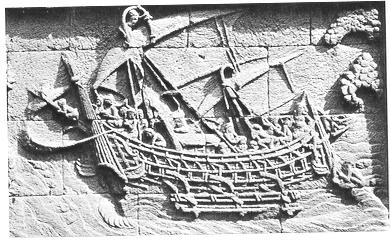 In
Kautalya Arthasastra the admiralty figures as a separate
department of the War Office; and this is a striking testimony to the importance
attached to it from very early times. In the Rg Veda Samhita boats and ships are
frequently mentioned. The classical example often quoted by every writer on the
subject is the naval expedition of Bhujya who was sent by his father with the
ship which had a hundred oars (aritra). Being ship-wrecked he was rescued by the
twin Asvins in their boat. In
Kautalya Arthasastra the admiralty figures as a separate
department of the War Office; and this is a striking testimony to the importance
attached to it from very early times. In the Rg Veda Samhita boats and ships are
frequently mentioned. The classical example often quoted by every writer on the
subject is the naval expedition of Bhujya who was sent by his father with the
ship which had a hundred oars (aritra). Being ship-wrecked he was rescued by the
twin Asvins in their boat.
(image
source: India: A concise history - By Francis Watson
p. 72).
"There was also extensive intercourse of India with
foreign countries, including the Mediterranean lands and the African continent,
naturally led to piracy on the waters. There then arose the need for the
protection of sea-borne trade, and we are told that “at the outset the
merchant vessels of India carried a small body of trained archers armed with
bows and arrows to repulse the attacks of the pirates, but later they employed
guns, cannon and other more deadly weapons of warfare with a few wonderful and
delusive contrivances.”
(source: The Commerce and Navigation of the
Ancients
In the Indian Ocean - William Vincent
pp. 457). These are probably the beginnings of the ancient Indian
navy. For
more refer to chapter on Greater
India: Suvarnabhumi and Sacred
Angkor.
In the Shanti Parvan
(59, 41) of the Mahabharata it is said that the
navy is one of the angas (part)of the complete army. Examples of ships being used for military
purposes are not lacking. When Vidura scented danger to Kunti’s five sons, he
made them escape to the forest with their mother, crossing the Ganges in a boat
equipped with weapons having the power of withstanding wind and wave. In the Dig
Vijaya portion of the Sabha parva, it is said that Sahadeva crossed the sea and
brought many islands under his sway after defeating the Mlecchas and other mixed
tribes inhabiting them. If this be an historical fact the inference is
irresistible that he could not have effected his conquest without the use of
boats and vessels. We read in the Ramayana that Durmukha, a Raksasa, who had
been fired bu the impulse of anger at the deeds of Hanuman, offered his services
to Ravana even to fight on the sea. This is testimony enough of the use of a
fleet for war purposes. There are other references here and there to ships in
the Ramayana. When Hanuman was crossing the ocean to Lanka, he is compared to a
ship tossed by winds on the high seas. Sugriva speaks of Sumatra, Java and even
the Red Sea, when sending forth his monkey hosts in quest of Sita.
 The Amarakosa, mentions a
number of nautical terms which stand for ship, anchorage (naubandhana), the helm
of the ship (naukarana), the helmsman (naukaranadhara). That there were
ships-building yards in different parts could be inferred from a significant
term navatakseni occurring in a copper plate grant of Dharmaditya dated 531.
A.D. The Amarakosa, mentions a
number of nautical terms which stand for ship, anchorage (naubandhana), the helm
of the ship (naukarana), the helmsman (naukaranadhara). That there were
ships-building yards in different parts could be inferred from a significant
term navatakseni occurring in a copper plate grant of Dharmaditya dated 531.
A.D.
About 517 B.C. according to Herodotus, Darius launched a maritime
expedition under Skylax of Caryanda to the Indus Delta, and during Alexander’s
time, again, we read of the people of the Punjab fitting out a fleet. We have
the testimony of Arrian to show that the Xathroi (Kshatri), one of the Punjab
tribes, supplied Alexander during his return voyage with thirty oared galleys
and transport vessels which were built by them.
(source: India and Its Invasion by Alexander
p. 156)
In the Manusamhita (Vii. 192), it is laid down that boats
should be employed for military purposes when the theatre of hostilities
abounded in water. Kamandaka (XVI, 50)
alludes to naval warfare when he says: "By regular practice one becomes an
adept in fighting from chariot, horses, elephants and boats, and a past-master
in archery." Manavadharmasastra refers to sea fights and attests to the
use of boats for naval warfare. The sailor is called naukakarmajiva. Thus in
Vedic, Epic and the Dharmasastra literature we find that naval warfare is
mentioned as a distinct entity, attesting a continuous naval tradition from the
earliest times. Yukti-kalpataru
specifies one class of ships called agramandira (because they had their cabins
towards the prows), as eminently adapted for naval warfare (rane kale ghanatyaye).
Passing on to other literary evidence, we find in the Raghuvamsa
frequent reference to boats and ships. Raghu in the course of his digvijaya
conquered Bengal which was protected by a fleet (nausadhanotyatan). In anther
place it is mentioned that Raghu marched on Persia through the land route, and
not by the sea route, thereby showing that the latter was the more common route.
 Historian
Dr. Vincent A. Smith says that
‘the creation of the Admiralty department was an innovation due to the genius
of Chandragupta. Historian
Dr. Vincent A. Smith says that
‘the creation of the Admiralty department was an innovation due to the genius
of Chandragupta.
"The Admiralty as a department of the State may have been a
creation of Chandragupta but there is evidence to show that the use of ships and
boats was known to the people of the Rg Veda. "
(source: Early History of
India - By Vincent Smith p 133).
In the following passage we have reference to a vessel with a hundred oats.
‘This exploit you achieved, Asvins in the ocean, where there is nothing to
give support, nothing to rest upon, nothing to cling to, that you brought Bhujya,
sailing in a hundred oared ship, to his father’s house.’
Further on in the Veda, this same vessel is described as a plava
which was storm-proof and which presented a pleasing appearance and had wings on
its sides. Another reference informs us that Tugra dispatched a fleet of four
vessels (Catasro navah) among which was the one referred to above. We may infer
from these passages that the Asvins were a great commercial people having their
home in a far-off island, and that their ruler Tugra maintained a fleet in the
interests of his State. There are also other references in the Rg Veda to show
that the ancient Indians were acquainted with the art of navigation. For
instance, Varuna is credited with a knowledge of the ocean routes along which
vessels sailed.
The Baudhayana Dharmasastra
speaks of Samudrasamyanam and interprets it as nava dvipantaragamanam, i. e.
Sailing to other lands by ships. This very term occurs in the navadhyaksa
section of the Kautaliya Arthasastra.
The Puranas have several references to the use of ships and
boats. The Markandeya Purana speaks of vessels tossing about on the sea. The
Varahapurana refers to the people who sailed far into the ocean in search of
pearls and oysters. The ships floated daily on the shoreless, deep and fearful
waters of the ocean. We are on firmer ground when we see in the Andhra period
their coins marked with ships. The ship building activities were great on the
east coast, and the Coromandel coast in particular. From this period to about 15th
century A.D. there was a regular intercourse with the islands of the Archipelago
most of which were colonized and also with ancient America right across the
Pacific as testified to us by the archaeological finds and inscriptions in those
parts.
(please refer to chapters on Pacific,
Suvarnabhumi and
Seafaring in Ancient India).
The Pali books of Sri Lanka
like the Mahavamsa refers to ocean going vessels
carrying 700 passengers. Such frequent intercourse and colonization through the
ages could not have been effected without a powerful fleet.

Ships Landing
of Prince Vijaya in Sri Lanka - 543 BC from Ajanta Frescos. Ajanta painting of a
later date depict horses and elephants aboard the ship which carried Prince
Vijaya to Sri Lanka.
(source: India Through the ages - By K. M. Panikkar).
For
more refer to chapter on Greater
India: Suvarnabhumi and Sacred
Angkor
***
But it is in a later work, the Yuktikalpataru
of Bhoja, that we have three classes of ships - the Sarvamandira, the
Madhyamandira, and Agramandira. The first was called Sarvamandira because it had
apartments all around. In the Sarvamandira were carried treasures, animals, and
ladies of the court. This was the vessel ordinarily used by kings in times of
peace. The Madhyamandira was so called because the living quarters were situated
in the middle. It was a sporting vessel and generally used in the rainy season.
The vessel of the third kind, the Agramandira, took its name from the
circumstance that the living room was located in front or at the top of the
vessel. The Agramandira was used for distant and perilous voyages and also
sea-fights.
There
are also in the Yuktikalpataru other references to vessels. There are 27 types
of ships mentioned here, the largest having the measurement 276 ft X 36 ft X 27
ft weighing roughly 2,300 tons. The following passage points to the use of ships
in warfare. The line: naukadyam vipadam jneyam makes it clear that naval
expeditions were common. Under the heading of yanam or march mention is made of
expeditions by land, water and air.
Kautilya remarks:
"Pirate ships (himsrika), boats from an enemy's country when they cross its
territorial limits, as well as vessels violating the customs and rules enforced
in port towns, should be pursued and destroyed." It is obvious that the
task set forth above could only be performed by armed vessels belonging to the
state.
From
this we may conclude that in ancient India ships were employed in warfare at
least as early as the Rig Vedic times. It is an incontrovertible fact that there
was a naval department in Mauryan times. We have the testimony of Megasthenes
that the navy was under a special officer called the Superintendent of
Navigation. This official was in turn controlled by the Admiralty
department. The officer whom Megasthenes refers to as Superintendent of
Navigation is called Navadhyaksa as already
seen, in the Arthasastra. The Greek accounts
bear testimony to the fact that navigation had attained a very high development
at the times of Alexander's invasion, for we are told that the invader was able
to secure a fleet from the Punjab at short notice. The Arthasastra lays down
some healthy regulations relating to navigation. Vessels which gave trouble or
were bound for the enemy's country, or transgressed the regulations of port
towns were to be destroyed.
A
considerable ship building activity is evident on the west coast of India also
as noted in the Sangam works of the Tamils. South India carried on political and
commercial activities as far as the Mediterranean in the early centuries of the
Christian era and before. The great Ceran Senguttavan had a fleet under
him.
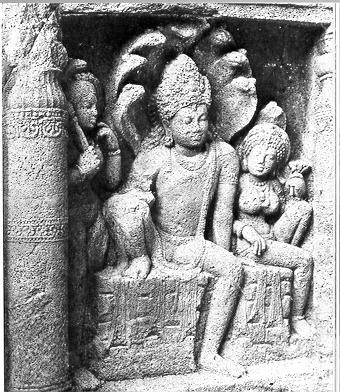
(image
source: Indian Art - By Roy C Craven p.
129).
***
Turning
to the history of South India, we have
evidence to show that the country had trade and culture contacts with foreign
countries like Rome in the west and Malay Archipelago and South east Asia in the
east. Yavana ships laden with articles of merchandise visited the west coast
frequently. There was active foreign trade between Tamil Indian and the outer
world at least from the time of Soloman, ie.
about 1000 B.C. Roman historians refer to the commercial intercourse that
existed between Rome and South India. In the first century before Christ we hear
of a Pandyan embassy to Augustus Caesar.
(refer to Periplus translated by Schoff p. 46).
The
Sangam classics point to the profession of pearl-diving and sea-fisheries on a
large scale. We hear of shipwrecks of the early Tamils saved now and then by
Manimekhalai, the goddess of the sea.
(Note:
ancient Tamil tradition
traces its origins to a submerged island or continent, Kumari
Kandam, situated to the south of India. The Tamil epics Shilappadikaram
and Manimekhalai provide glorious
descriptions of the legendary city and port of Puhar, which the second text says
was swallowed by the sea. As in the case of Dwaraka, (please refer to chapter on
Dwaraka and Aryan
Invasion Theory), initial
findings at and off Poompuhar, at the mouth
of the Cauvery, show that there may well be a historical basis to this legend:
apart from several structures excavated near the shore, such as brick walls,
water reservoirs, even a wharf (all dated 200-300 B.C.), a few years ago a
structure tantalizingly described as a "U-shaped stone structure" was
found five kilometers offshore, at a depth of twenty-three meters; it is about
forty meters long and twenty wide, and fishermen traditionally believed that a
submerged temple existed at that exact spot. If the structure is confirmed to be
man-made (and not a natural formation), its great depth would certainly push
back the antiquity of Puhar. Only more systematic explorations along Tamil
Nadu's coast, especially at Poompuhar, Mahabalipuram, and around Kanyakumari
(where fishermen have long reported submerged structures too) can throw more
light on the lost cities, and on the traditions of Kumari
Kandam, which some have sought to identify with the mythical Lemuria).

ancient city in India.
(image
source: The Wonder that was India - By A L Basham
p. 199).
We
have the account of a Cera King conquering the Kadamba in the midst of sea
waters. The Cera King Senguttuvan had a
fleet with which he defeated the Yavanas who were punished with their hands
being tied behind their backs and the pouring of oil on their heads. The Cholas
also maintained a strong fleet with which they not only invaded and subjugated
Lanka but also undertook overseas expeditions. Among the conquests of Rajaraja,
Lanka was one, and his invasion of that island finds expression in the Tiruvalangadu
plates, where it is described as follows:
"Rama
built, with the aid of the monkeys, a causeway over the sea and then slew with
great difficulty the king of Lanka by means of sharp-edged arrows. But Rama was
excelled by this (king) whose powerful army crossed the ocean in ships and burnt
the king of Lanka."
Rajaraja
also sent an expedition against the Twelve Thousand Islands, obviously a
reference to the Laccadives and Maldives. Friendly embassies were also sent by
the Chola king to China.
From
the evidence of the Mahvamsa as well as from a few inscriptions we are able to
gather some information regarding the diplomatic relations that existed between
India and Sri Lanka. We have the story of Vijaya and his followers occupying the
island about 543 B.C. Vijaya was a prince of North India who was banished from
the kingdom by his father. Passing through the southern Magadha country he
sailed to Sri Lanka, according to the Rajavali,
in a fleet carrying more than 700 soliders, defeated the Yaksas inhabiting it,
and settled there permanently. This story is illustrated in the Ajanta
frescoes.

Numerous
ships carried the troops of Rajendra to Sri Vijaya and its dependencies which he
conquered. Among the places conquered were Pannai (Pani or Panei on the east
coast of Sumatra), Malaiyur (at the southern end of the Malay Peninsula),
Mappappalam ( a place in the Talaing country of Lower Burma), Mudammalingam (a
place facing the gulf of Siam), Nakkavaram (the Nicobar islands. Besides, active
trade was carried on between South India and China during this period.
At
the end of the 10th century the Chinese emperor sent a mission to the Chola king
with credentials under the imperial seal and provisions of gold and piece-goods
to induce the foreign traders of the South Sea and those who went to foreign
lands beyond the sea for trade to come to China.
The
facts clearly show that the Cholas maintained supremacy over the sea and kept a
strong and powerful navy which was useful not only for carrying on extensive
commerce with foreign countries but also for conducting military expeditions.
During the days of the Kakatiyas of Warangal, Motupalle (Guntur District) was
the chief port, on the east coast. Ganapatideva, the Kakatiya ruler, extirpated
piracy on the sea and made the sea safe for commerce with foreign countries like
China and Zanzibar. This policy was pursued by Rudramba, his
daughter.
Vijayanagar
kingdom also claimed supremacy over the sea. Since the days of Harihara I the
rulers of Vijayanagar took the title of the Lord of the Eastern, Western and
Southern oceans; and there were 300 ports in the empire. The activities of the
Vijayanagar fleet on the west coast are also referred to by the Portuguese in
1506.
The Vijayanagar kings sent friendly embassies to
foreign courts. 'Bukka I sent an embassy through his chief explainer to the
court of Taitsu, the King Emperor of China, with tributes and large presents,
among which was a stone which was valuable in neutralizing poison.

Accounts
of Foreign Travelers to India
Coming
to later times we have the account of Hiuen Tsang
who notices a fleet of 3,000 sail belonging to the King os Assam. There is
inscriptional evidence of the possession of a fleet under the Kakatiyas and the
Cholas in South india. Marco Polo testifies
to the huge size and efficient construction of Indian vessels while Yule
in his Cathey refers to Rajput
ships en route to China. Marco Polo, a famous Venetian traveler who visited
India in 13th Century also visited Thane Port. The first chapter of his book
which deals with India is almost devoted to shipbuilding industry in India. Friar
Odoric of Pordenone, an Italian Monk who visited India in 14th
Century, in his account of his voyage across the Indian Ocean, a mention is made
of ships which can carry 700 people.
"Ships
of size that carried Fahien from India to China (through stormy China water)
were certainly capable of proceeding all the way to Mexico and Peru by crossing
the Pacific. One thousand years before the birth of Columbus Indian ships were
far superior to any made in Europe upto the 18th century."
(source: The
Civilizations of Ancient America:
The Selected Papers of the XXIXth
International Congress of Americanists - edited
Sol Tax 1951).
Ludovico
di Varthema (1503 A. D) saw vessels of 1,000 tons burden built at Masulipatnam. According to Dr. Vincent, India built great sized vessels from the
time of Agathareids (171 B.C.) to the 16th century. And no wonder the
Portuguese, when they first landed at the west coast, were carried away by the
excellent Indian vessels. Later still, the Vijayanagar Empire, which had as many
as 300 ports, had a powerful fleet. The naval commander was styled
Naviyadaprabhu.
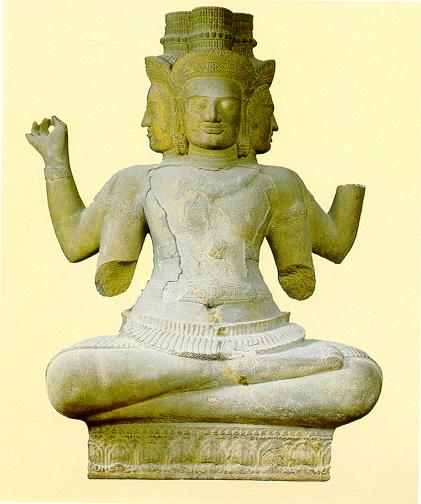 India has a coastline of about 6300 kms.
Extensive new archaeological, epigraphical, sculptural and literary material has
been added to our knowledge since the early decades of this century. Dr.
Radha Kumud
Mookerji's Book Indian Shipping - A History of the Sea-Borne Trade and Marine
Activity of The Indians From The Earliest Times published in 1912
Orient Longmans ISBN 8121509165) is the most comprehensive study of Indian Navigation up to that
period. We now know that many ports on both Eastern and Western Coast had
navigational and trade links with almost all Continents of the world. There are
many natural and technological reasons for this. Apart from Mathematics and
Astronomy, India had excellent manufacturing skills in textile, metal works and
paints. India had abundant supply of Timber. Indian - built ships were superior
as they were built of Teak which resists the effect of salt water and weather
for a very long time. India has a coastline of about 6300 kms.
Extensive new archaeological, epigraphical, sculptural and literary material has
been added to our knowledge since the early decades of this century. Dr.
Radha Kumud
Mookerji's Book Indian Shipping - A History of the Sea-Borne Trade and Marine
Activity of The Indians From The Earliest Times published in 1912
Orient Longmans ISBN 8121509165) is the most comprehensive study of Indian Navigation up to that
period. We now know that many ports on both Eastern and Western Coast had
navigational and trade links with almost all Continents of the world. There are
many natural and technological reasons for this. Apart from Mathematics and
Astronomy, India had excellent manufacturing skills in textile, metal works and
paints. India had abundant supply of Timber. Indian - built ships were superior
as they were built of Teak which resists the effect of salt water and weather
for a very long time.
"The art of
Navigation was born in river Sindhu 6000 years ago. The very word navigation is
derived from Sanskrit word Nav (or Nav-ship) Gatih."
Lieut. Col. A Walker's paper: "Considerations of the affairs of
India" written in 1811 had excellent remarks on Bombay-built ships. He
notes, "situated as she is between the forests of Malabar and Gujarat, she
receives supplies of timber with every wind that blows." Further he says,
"it is calculated that every ship in the Navy of Great Britain is renewed
every twelve years. It is well known that teakwood built ships last fifty years
and upwards. Many ships Bombay-built after running fourteen or fifteen years
have been brought into the Navy and were considered as stronger as ever. The Sir
Edward Hughes performed, I believe, eight voyages as an Indiaman before she was
purchased for the Navy. No Europe-built Indiaman is capable of going more than
six voyages with safety."
He has also further noted that Bombay-built ships
are at least one-fourth cheaper than those built in the docks of England. Francois
Balazar Solvyns, a Belgian/Flemish maritime painter, wrote a book titled
Les
Hindous in 1811.
His remarks are, "In ancient times, the
Indians excelled in the art of constructing vessels, and the present Hindus can
in this respect still offer models to Europe-so much so that the English,
attentive to everything which relates to naval architecture, have borrowed from
the Hindus many improvement which they have adopted with success to their own
shipping.... The Indian vessels unite elegance and utility and are models of
patience and fine workmanship."
(source: http://www.orientalthane.com/speeches/speech_2.htm).
(For more
refer to chapter on Greater
India: Suvarnabhumi and Sacred
Angkor).
Surprisingly, many earlier western traders and
travelers have expressed the same views. Madapollum was a flourishing shipping
centre. Thomas Bowrey, an English traveler
who visited India during 1669-79, observes, " many English merchants and
others have their ships and vessels yearly built (at Madapollum). Here is the
best and well grown timber in sufficient plenty, the best iron upon the coast,
any sort of ironwork is ingeniously performed by the natives, as spikes, bolts,
anchors, and the like. Very expert master-builders there are several here, they
build very well, and launch with as much discretion as I have seen in any part
of the world. They have an excellent way of making shrouds, stays, or any other
rigging for ships".
A
Venetian traveler of 16th Century Cesare de Fedrici,
while commenting on the East Coast of India has noted that there is an abundance
of material for ship building in this area and many Sultans of Constantinople
found it cheaper to have their vessels built in India than at Alexandria.
Nicol
Conti who visited India in 15th century was impressed by the quality Indians had
achieved in ship building. He observes:
"The nations of India build some ships larger than ours, capable of containing
2,000 butts, and with five sails and as many masts. The lower part is
constructed with triple planks, in order to withstand the force of the tempests
to which they are much exposed. But some ships are so built in compartments that
should one part be shattered, the other portion remaining entire may accomplish
the voyage."
J.
Ovington, Chaplain to the British King, the seventeenth-century English traveler,
who visited Surat, wrote a book A
Voyage to Surat in the Year 1689.
He was impressed by the skill of
the Indians in ship-building and found that they even outshone Europeans. The
timber used by the Indians was so strong that it would not ‘crack’ even by
the force of a bullet so he urged the English to use that timber ‘to help them
in war’. Indian Teak stood firmer than the English Oak, remarked Ovington.
Thomas
Herbert, a traveler who visited Surat in 1627, has given an
interesting account of the arrival, loading and unloading of ships through small
boats at Swally marine (Sohaly), a few kilometres away from Surat. He remarked
that between September and March every year, the port of Sohaly presented a very
busy and noisy scene for there came many ships from foreign lands. The merchants
(baniyas) erected their straw huts in large numbers all along the sea
coast, making the whole place thus look like a country fair. The merchants sold
various commodities like calicoes, ivory, agates, etc. Many small boys engaged
by the merchants were seen running about doing odd jobs. The English found that
the small boats used and constructed by the natives could be of immense use.
This was a definite gain for both nations. Boats and rafts were used as a means
of conveyance for loading and unloading ships. There were about 4200 big and
4400 small boats. There were large-sized boats that could carry even elephants.
The boats used by kings and nobles were designed to look artistic. Abul
Fazl writes about the "wonderfully fashioned boats with
delightful quarters and decks and gardens"
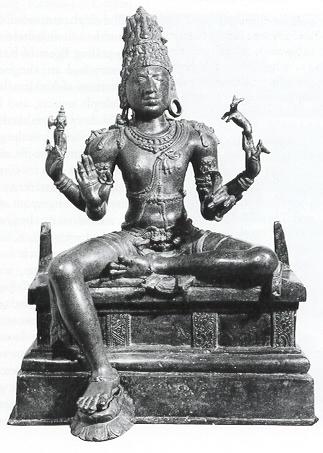
(image
source: India: A concise history - By Francis Watson
p. 33).
For
more refer to chapter on Greater
India: Suvarnabhumi and
Ethereal Prambanan and Sacred
Angkor
***
Among the
primitive Indian boats, the cattarmaran
comes first. It consisted of three logs and three spreaders and cross lashings.
The centre log was the largest, and pointed towards one end. Mainly fishermen
used the cattarmaran for fishing. A little more skillfully made is the musoola
boat, which has no iron fastening. It was mostly used in the Coromandel coast.
Dr John Fryer says, "It is possible that the name musoola may be connected
with Masulipatarn where boats seem to have been in use".
Another
boat made in an indigenous manner was known as dingy.
It was hollowed out from a single trunk. Lower down the Ganga, the name was
applied to boats half-decked, half wagon-roofed and built of planks.
Purqoo
was another type of boat described by Thomas Bowery. It plied between the
Hooghly and Balasore. These boats were made very strong to carry ‘sufficient
load’. They were also used for loading ships. they could remain in water for a
long time without getting damaged. As
compared to the purqoo, boora was a ‘lighter boat’ which rowed with 29 or 30
oars. These boats were also used for carrying saltpeter and other commodities.
(source: Coastal
trade flourished with Europeans - By
Pramod Sangar).
 Sir
John Malcolm (1769
- 1833) was a Scottish soldier, statesman, and historian entered the service of
the East India Company wrote about Indian vessels that they: Sir
John Malcolm (1769
- 1833) was a Scottish soldier, statesman, and historian entered the service of
the East India Company wrote about Indian vessels that they:
"Indian
vessels are so admirably adapted to the purpose for which they are required
that, notwithstanding their superior science, Europeans were unable, during an
intercourse with India for two centuries, to suggest or to bring into successful
practice one improvement."
(source:
Journal
of Royal Asiatic Society, Vol. I and India
and World Civilization -
By D P Singhal part II p. 76 - 77).
In
the middle of the 18th century, John Grose
noted that at Surat the Indian ship-building industry was very well established,
indeed, “They built incomparably the best ships in the world for duration”,
and of all sizes with a capacity of over a thousand tons. Their design appeared
to him to be a “a bit clumsy” but their durability soundly impressed him. They
lasted “for a century”.
Lord Grenville mentions, in this connection, a ship built in Surat
which continued to navigate up the Red Sea from 1702 when it was first mentioned
in Dutch letters as “the old ships” up to the year 1700.” Grenville
also noted that ships of war and merchandise “not exceeding 500 tons” were
being built” with facility, convenience and cheapness” at the ports of
Coringa and Narsapore.
Dr.
H. Scott sent samples of dammer
to London, as this vegetable substance was used by the Indians to line the
bottom of their ships; he thought it would be a good substitute “in this
country for the materials which are brought from the northern nations for our
navy…There can be no doubt that you would find dammer in this way an excellent
substitute for pitch and tar and for many purposes much superior to them.”
source:
Decolonizing
History: Technology and Culture in India, China and the West 1492 to the Present
Day - By Claude Alvares p. 68-69).
Alain Danielou
(1907- 1994) son of French
aristocracy, author of numerous books on philosophy, religion, history and arts
of India has written:
"India's naval
dockyards, which belonged to the state, were famous throughout history. The
sailors were paid by the state, and the admiral of the fleet hired the ships and
crew to tradesmen for transporting goods and passengers. When the British
annexed the country much later on, they utilized the Indian dockyards - which
were much better organized then those in the West - to build most of the ships
for the British navy, for as long as ships were made of wood."
(source: A
Brief History of India - By Alain Danielou p. 106).
"...an
Indian naval pilot, named Kanha, was hired
by Vasco da Gama to take him to India. Contrary to European portrayals that
Indians knew only coastal navigation, deep-sea shipping had existed in India.
Indian ships had been sailing to islands such as the Andamans, Lakshdweep and
Maldives, around 2,000 years ago. Kautiliya's shastras describe the times that
are good and bad for seafaring. In the medieval period, Arab sailors purchased
their boats in India. The Portuguese also continued to
get their boats from India, and not from Europe. Shipbuilding and exporting was
a major Indian industry, until the British banned it. There is
extensive archival material on the Indian Ocean trade in Greek, Roman, and
Southeast Asian sources."
(source: History
of Indian Science & Technology).
For more on Shipbuilding in
Ancient India, please refer to chapter Seafaring
In Ancient India).
***
India became
the first power to defeat a European power in a naval battle - The Battle of
Colachel in 1742 CE.
A
dramatic and virtually unknown past, in an area of bucolic calm surrounded by
spectacular hills: that is Colachel, a name that should be better known to us.
For this is where, in 1741, an extraordinary event took place -- the Battle of
Colachel. For the first, and perhaps the only time in Indian history, an Indian
kingdom defeated a European naval force. The ruler of
Travancore, Marthanda Varma, routed an invading Dutch fleet; the Dutch
commander, Delannoy, joined the Travancore army and served for decades; the
Dutch never recovered from this debacle and were never again a colonial threat
to India.


The
ruler of Travancore, Marthanda Varma, routed an invading Dutch fleet; the Dutch
commander, Delannoy, joined the Travancore army and served for decades; the
Dutch never recovered from this debacle and were never again a colonial threat
to India.
For
more refer to chapter on Greater
India: Suvarnabhumi and Sacred
Angkor
***
The Battle of Colachel in 1742 CE, where
Marthanda Varma of Travancore crushed a Dutch expeditionary fleet near
Kanyakumari. The defeat was so total that the Dutch captain, Delannoy, joined
the Travancore forces and served loyally for 35 years--and his tomb is still in
a coastal fort there. So it wasn't the Japanese in the Yellow Sea in 1905 under
Admiral Tojo who were the first Asian power to defeat a European power in a
naval battle--it was little Travancore. The Portuguese and the Dutch were
trying to gain political power in India at that time. Marthanda Varma defeated
the Dutch in 1741. He was an able ruler. He established peace in his country -
Travancore. It
was a remarkable achievement for a small princely state.
(source:
The
Battle of Colachel: In remembrance of things past - By Rajeev Srinivasan -
rediff.com and
http://www.kerala.com/kera/culture1.htm). For
more refer to chapter on Glimpses
IX).
For
more information on Navy refer to chapters on Pacific,
Suvarnabhumi and
Seafaring in Ancient India).
Top
of Page
Diplomacy
and War
Not
withstanding the elaborate rule of war laid down in the epics and the law-books,
insisting in the main that to wage war was the duty and privilege of every true
Ksatriya, in several cases the horrors of war made the belligerent think of the
consequences and avoid outbreak of hostilities by a well calculated policy which
we now term diplomacy.
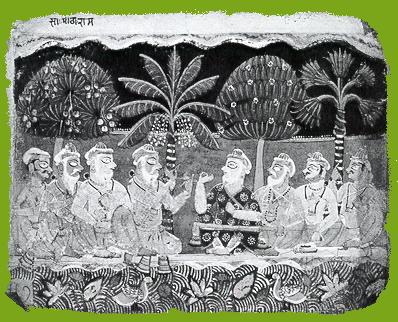
King seeking
counsel.
(image
source: India: A concise history - By Francis Watson
p. 37).
***
Negotiation, persuasion and
conciliation were cardinal points of the ancient Indian diplomatic system, and
were effective instruments in averting many a war, which would otherwise have
realized in much bloodshed and economic distress.
The political term for
diplomacy is naya, and the opinion of Kautalya,
the eminent politician of the 4th century B.C., a king who understands the true
implications of diplomacy conquers the whole earth.
The history of diplomacy in
ancient India commences with the Rig Veda Samhita, and the date of its
composition may be taken as far back as the Chalcolithic period. In the battles
the help of Agni is invoked to overcome enemies. He is to be the deceiver of
foes. In pursuing his mission to a successful end, the use of spies is
mentioned. This bears eloquent testimony to the system of espionage prevalent so
early as the time of the Rig Veda Samhita. In the battle of the Ten Kings
described in the seventh mandala, we find diplomacy of rulers getting
supplemented by its association with priestly diplomacy, which exercised a
healthy influence on the constitutional evolution.
International Relations - The
picture presented in the epics and the Arthasastra
literature seems to be confined to the four corners of Bharatkhanda.
The intercourse as envisaged in the literature, shows
relations to be more commerical than political in character.
Strabo quotes Megasthenes and
says that Indians were not engaged in wars with foreigners outside India nor was
their country invaded by foreign power except by Hercules and Dionsysius and
lately by the Macedonians. There were friendly
relations of Chandragupta with Seleukos Nikator, of Bindusara with Antiochus, of
Asoka and Samadragupta with Lanka, of Pulaskesi with Persians, of Harsha with
Nepal and China, of the Cholas with Sri Vijaya.
"It was always regarded as
a legitimate object of the ambition of every king to aim at the position of Cakravartin
or Sarvabhuuma (paramount sovereign or of supreme monarch)."
This ambition was legitimate and had no narrow outlook about it. It was a fruit
to be sought after by every one of the monarchs comprising the mandala. If the
king is not actuated by this idea, he falls short of an ideal king according to
the Hindu Rajadharma.
Diplomatic agents - ambassadors
Bhisma mentions seven
qualifications as essential in an ambassador: he should come from a noble line,
belong to a high family, be skilful, eloquent of speech, true in delivering the
mission, and of excellent memory.

Indian army
on the march.
(image
source: Universal History of the World - volume 1 - By
John Bowman p. 79).
***
Espionage in War - Spies filled
an important role in both the civil and military affairs of ancient India. The
institution of spies had a greater utility, as the king could take action on the
report of the spies. Spies were engaged to look after the home officials,
including those of the royal household as well as to report on the doings in the
enemy kingdoms. The Rig Veda Samhita, often speaks of spies (spasah) of Varuna.
Only men of wisdom and purity were sent on this errand, thus suggesting that
they should be persons above corruption and temptation of any sort. In the epics
and post-epic literature in general, spies have been described as the 'eyes of
the king'. In the Udyoga-parva (33, 34) of Mahabharata,
it
is stated that "cows see by smell, priests by knowledge, kings by spies,
and others through eyes." Spies roamed about in foreign states under
various disguises to collect reliable information. In the Ramayana,
a king mentions the wise adage that "the enemy, whose secrets have been
known through espionage, can be conquered without much effort." The Arthashastra, which predates Christ by centuries, dwells at length on the
importance of espionage and the creation of an effective spy network.
Such details may indicate the
high development of the science of diplomacy in ancient India. It
was the famous Indian strategist of the fourth-century B.C, Kautilya
in the Arthasastra,
who gave the world the dictum:
"The enemy of my enemy is my friend."
"The
same style of Indian thought" says Heinrich
Zimmer in his book, Philosophies
of India, p. 139, admiringly
of Kautilya, "that
invented the game of chess grasped with profound insight the rules of this
larger game of power."
Attitude to war - The Sangam
age of the Tamils was the heroic age of the Tamil Indians. If the men of the
Tamil land were heroes, then their women were heroines. A certain mother was
asked where her son was, and she replied, that she was sure that the tiger that
had lain in her womb would be found in the field of battle. War was the
pabulum on which our ancient warriors were great in name and fame. A certain
lady who gave birth to only one son and who sent hime to the field of battle
when there was the country's call for it. Okkurmasattiyar,
a poetess, praises a certain lady dresses the hair of her only son and gives him
the armor to get ready for action in the field of battle. This may be contrasted
with another where a heroic mother heard the disquieting news that her son lost
his courage in action and had fled in fear. If it were true, she expressed that
she would cut off her breasts that had fed him with milk. With this
determination she entered the battle-field with sword in her hand and went on
searching for her fallen son. When she saw her son's body cut in twain, she felt
much more happy than when she gave birth to him. (source: Puram
277 and 279 - in Tamil ).
Flags - The origin and use of
flags can be traced to the earliest Indian literature, the Rig Veda Samhita. The
term deaja occurs twice in the Veda. Besides, dhvaja, we meet with a good number
of expressions for a banner in Vedic literature. These are Akra, Krtadhvaja,
Ketu, Brhatketu, Sahasraketu. It appears that the Vedic host aimed their arrows
at the banners of the enemy. The idea was that once the banner was captured, or
struck, a claim was made for success in the battle over the enemy. Ketu was a
small flag as contrasted with Brhatketu or the big flag. Sahasraketu may be a
thousand flag, or as the knight who brought under control a thousand flags of
enemies. We are told that banners and drums were counted among the insignia of
ancient Vedic kings. In the Mahabharata war, every leader had his own insignia
to distinguish one division from the other. Arjuna had the
Kapidhvaja or the
flag with the figure of Hanuman, Bhisma, Taladhvaja, cognizance of a palmyra
tree etc..
Top
of Page
Conclusion
The foregoing survey may
convince an impartial student of history that the ancient Hindus had evolved
precepts on fair fighting which formed a chivalrous code of military honor.
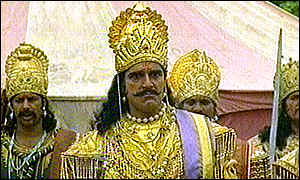 On the whole, however, it would
seem that wars in ancient India were characterized by less violence and savagery
than wars elsewhere. There is no recorded instance of such wanton and
cold-blooded atrocity as Athens perpetrated against Melos, Corcyra and Mytilene,
or the wearers of the Cross against the defenders of the Crescent in 1099 A.D.
Such incidents of war as the indiscriminate slaughter of all men of military age
or the enslavement of women and children of the conquered state were hardly
known. On the whole, the chiefs were considerate of each other's rights. On the whole, however, it would
seem that wars in ancient India were characterized by less violence and savagery
than wars elsewhere. There is no recorded instance of such wanton and
cold-blooded atrocity as Athens perpetrated against Melos, Corcyra and Mytilene,
or the wearers of the Cross against the defenders of the Crescent in 1099 A.D.
Such incidents of war as the indiscriminate slaughter of all men of military age
or the enslavement of women and children of the conquered state were hardly
known. On the whole, the chiefs were considerate of each other's rights.
This was also the Kautilyan ideal of dharmavijayan, and the typical Hindu method
of creating unity out of diversity in the political sphere. It was a
well-established maxim of statecraft that a victor should acquiesce in the
continuance of the laws, beliefs and customs of the vanquished peoples, and
that instead of seeking to extermination of the defeated dynasties, he should be
content with submission and tribute. It is also the reason why some of the
princely families in India can boast of an ancestry unequalled by any royal
house in Europe.
It is of paramount importance
to remember that in India the social, economic and religious life of the people
pursued their course irrespective of the activities of the state. As early as as
the 4th century B.C. Megasthenes noticed a
peculiar trait of Indian warfare.
"Whereas among other
nations it is usual in the contests of war to ravage the soil, and thus to
reduce it to an uncultivated waste, among the Indians, on the contrary, by whom
husbandmen, the tillers of the soil, even if battle is raging in the
neighborhood, are undisturbed by any sense of danger, for the combatants on
either side, in waging the conflict, make carnage of each other but allow those
engaged in husbandry to remain quite unmolested. Besides they never ravage an
enemy's land with fire nor cut down its trees." The modern "scorched
earth" policy was then unknown.
Professor H.
H. Wilson says: "The Hindu laws of war
are very chivalrous and humane, and prohibit the slaying of the unarmed, of
women, of the old, and of the conquered."
 At the very time when a battle was going on,
be says, the neighboring cultivators might be seen quietly pursuing their work,
- " perhaps ploughing, gathering for crops, pruning the trees, or reaping
the harvest." Chinese pilgrim to Nalanda
University, Hiuen Tsiang affirms that
although there were enough of rivalries and wars in the 7th century A.D. the
country at large was little injured by them.
At the very time when a battle was going on,
be says, the neighboring cultivators might be seen quietly pursuing their work,
- " perhaps ploughing, gathering for crops, pruning the trees, or reaping
the harvest." Chinese pilgrim to Nalanda
University, Hiuen Tsiang affirms that
although there were enough of rivalries and wars in the 7th century A.D. the
country at large was little injured by them.
Colonel
James Tod, author of Annals
and Antiquities of Rajasthan: or the Central and Western Rajput States of India
South Asia Books; ; 2 edition (April 1998) ISBN 8120803809
wrote: "To spare a prostrate foe is the creed of the Hindu
cavalier, and he carried all such maxims to excess."
What were the causes which led
to the downfall of the Hindus? Why did the Indian states fall prey to the
Muhammadan Turks in the 11th and 12th century?
King
Asoka wanted to convert his empire into an open-air Buddhist
monastery, at the expense of Hindu taxpayers whose interests in turn were
marginalized. Buddhist principles derided martial prowess and criminally
neglected the intrepidity and valor which fought for national independence. The
excessive propaganda for unrestricted ahimsa which King Asoka carried on
by his use of political authority throughout his empire, cut at the very root of
the Indian empire.
For
a few generations following Ashoka's demise, 'non-violent' Buddhists ate into
the vitals of India's external defence, leaving the country vulnerable to a
second wave of Greek attacks.
According
to Priyadarshi Dutta:
"The Greeks, who had concluded a treaty with Chandra-gupta Maurya,
moved in to Ayodha before the Kalinga King Kharvela
repulsed them. Later Pushyamita Sunga assassinated the last Maurya King and
salvaged India. Buddhism vanished from India
as a result of Muslim onslaught because none of them had the liver of the likes
of say, Guru Govind Singh. While Hindus and Sikhs
resisted Muslim onslaught, Buddhist submitted en mass to Islam."
The Hindu defenders of the
country although fully equal to their assailants in courage and contempt of
death were nevertheless, divided among themselves. This division and disunion
also enabled the crafty Turk invaders from the north to exploit the differences
within the country. Hindus were more civilized and prosperous than the Turks.
Moreover, the Turks had rude rigor of a semi-civilized barbarians who combined
the fierce religious zeal of neo-converts. To spread their faith by conquest
doubled their natural zest for battle and endowed them with the devoted valor of
martyrs. In addition, the concept of ahimsa tended to create in certain sections
of Hindus a deep abhorrence to all forms of violence.
The Bhagavad Gita's great
message: that violence is sometimes necessary, if it flows from Dharma.
Non-violence in thought, word and deed is the ideal of the yogi, as the Gita
points out. Violence is never an ideal in a civilized society, but it cannot be
avoided. Rulers of society have to employ it for their preservation. Even this
terrible action can be performed as selfless service when lawless societies (eg.
Muhammadan Turks or Europeans who came to India as invaders) prey upon others out of greed.

The Bhagavad Gita's great
message: that violence is sometimes necessary, if it flows from Dharma
 
For a warrior, nothing is higher than a
war
against evil.
The warrior confronted with such a war should be pleased, Arjuna, for it comes
as an open gate to heaven.
But if you do not participate in this battle against evil, you will incur sin,
violating your dharma and your honor....
- Bhagavad Gita 2.31-33
  
Books
used
for this chapter
War
in Ancient India - By V. R. Ramachandra Dikshitar
'Six
Glorious Epochs of Indian History' - By Veer Vinayak Damador Savarkar
German
Indologists: Biographies of Scholars in Indian Studies writing in German
- By Valentine Stache-Rosen.
Sword of Truth: Indian
Marine Archaeology and its Historical Context - By Dr.
Vijay Bedekar
The Art of
War in Ancient India - By P. C. Chakravarti
Re-inventing
a political Buddha - By Priyadarshi Dutta
Hindu
America: revealing the story of the romance of the Surya Vanshi
Hindus and depicting the imprints of Hindu culture on the two Americas -
By Chaman Lal with foreword by Dr. S.
Radhakrishnan. 3d ed. (LC
History-America-E) 1966).
Top
of Page
Articles
Sailors of
Sixty Centuries
Yukikalpataru, a Sanskrit manuscript compilation by
Bhoja
Narapati, which manuscript is now in the Calcutta Sanskrit College Library, is
something like a treatise, on the art of shipbuilding in Ancient India.
It gives, according to Vriksha-Ayurveda (“Botany”), an
account of four different kinds of wood. The first class comprises wood, that is
light and soft, and can be joined to any other wood. The second class is light
and hard, but cannot be joined to any other class of wood. The third class of
wood is soft and heavy. Lastly the fourth kind is hard and heavy. According to
Bhoja, a ship made out of the second class of wood, brings wealth and happiness.
Ships of this type can be safely used for crossing the oceans. Ships made out of
timbers containing different properties are not good, as they rot in water, and
split and sink at the slightest shock.
Bhoja says that care should be taken that no iron be used, in
joining planks, but they be subjected to the influence of magnetism, but they
are to be fitted together with substances other than iron. Bhoja also gives
names of the different classes of ships:
- River-going
ships –Samanya;
- Ocean-going
ships – Visesa.
The measurements in cubits of the “Ordinary class” of
ships are the following:
|
|
Length |
Breadth |
Height |
|
1. |
Kshudra |
16 |
4 |
4 |
|
2 |
Madhyama |
24 |
12 |
8 |
|
3 |
Bhima |
40 |
20 |
20 |
|
4 |
Chapala |
48 |
24 |
24 |
|
5 |
Patala |
64 |
32 |
32 |
| 6 |
Bhaya |
72 |
36 |
36 |
| 7 |
Dirgha |
88 |
44 |
44 |
| 8 |
Patraputa |
96 |
48 |
48 |
| 9 |
Garbhara |
112 |
56 |
56 |
|
10 |
Manthra |
120 |
60 |
60 |
Bhima,
Bhaya, Garbhara are liable to bring ill-luck because
their dimensions are such as not to balance themselves in water.
Among the “Special” are two classes.
1.
Dirgha
|
|
Length |
Breadth |
Height |
|
1. |
Dirghika |
32 |
4 |
31/5 |
|
2 |
Tarani |
48 |
6 |
44/5 |
|
3 |
Lota |
64 |
8 |
62/5 |
|
4 |
Gatvara |
80 |
10 |
8 |
|
5 |
Gamini |
96 |
12 |
92/5 |
| 6 |
Tari |
112 |
14 |
111/5 |
| 7 |
Jangala |
128 |
16 |
124/5 |
| 8 |
Plavini |
144 |
18 |
142/5 |
| 9 |
Dharnini |
160 |
20 |
16 |
|
10 |
Begini |
176 |
22 |
173/5 |
2. Unnanta
| a |
Urddhva |
22 |
16 |
16 |
| b |
Anurddva |
48 |
24 |
24 |
| c |
Svanamukhi |
64 |
32 |
32 |
| d |
Gharbhini |
80 |
40 |
40 |
| e |
Manthara |
96 |
48 |
48 |
Lota, Gamini, Plavini, Anurddhava, Gharbhini, Manthara bring
misfortune, because of their dimensions, and Urddhva much gain.
The “Yaktikalpataru” also suggests the metals to be used
in decorations, eg. Gold, silver, copper, and compounds of all three as well as
the colors. A vessel with four masts is to be painted white, the one with three
masts is to be given a red paint, a two masted vessel is to be colored yellow,
and a one masted vessel is to have a blue color. The prows are to be shaped into
the form of heads of lions, buffalos, serpents, elephants, tigers, ducks,
pea-hens, parrots and human beings, thus arguing an advanced progress in
carpentry. Pearl and gold garlands are to decorate the prows.
Three classes of Ships:
According to cabins, ships are to be grouped into three
classes:
Sarvamandira
ships, having the largest cabin, from one end of the ship to the other. These
are to be used for the transportation of the royal treasury, of women and
horses. Madhyamandira ships, with cabins in the rainy season. Ships with cabins
near the prows, are called Agramandira, and are for sailings in the dry seasons
as well as for long voyages, and naval warfare.It was in these ships, that the
first naval battle recorded in Indian literature, was fought, when Tugra, the
Rishi King, sent his son Bhujyu against his enemies inhabiting some Island, and
Bhujya on being wrecked, was rescued by two Asvins, in their hundred oared
gallery. Of the same description are the five hundred vessels, mentioned in the
Ramayana.
Carried 1000 Passengers: In Rajavalliya, the ship in which Prince Vijaya
and his followers were sent away by King Sinhala of Bengal, was large enough to
accommodate seven hundred passengers. The ship in which Prince Vijaya’s bride
was conveyed to Sri Lanka, was big enough to accommodate eight hundred people of
the bride’s party. The ship which took Prince Sinhala to Sri Lanka contained
five hundred merchants besides the Prince himself. The Janaka Jataka mentions a
ship-wreck of seven hundred passengers. The ship by which was effected the
rescue of the Brahmin mentioned in Sankha Jataka was 800 cubits in length, 600
cubits in width, 20 fathoms deep, and had three masts. The ship mentioned in the
Samuddha Vanija Jataka was big enough to transport a village full of absconding
carpenters, numbering a thousand, who had failed to deliver goods paid for in
advance.
Early History: An ancient couplet
betrays the spirit with which the Indians were imbued and which accounts for
their wonderful achievements on land, beyond seas and across mountain barriers.
There is indeed evidence to show that the sons of the soil were adept at
navigation both riverine and oceanic. Right from the dawn of history, therefore,
Indians have been engaged in plying boats and ships, carrying cargoes and
passengers, manufacturing vessels of all types and dimensions, studying the
stars and winds, erecting light-houses and building ports, wharfs, dockyards and
warehouses. From rustic beginnings they developed a precise science of
navigation and composed regular manuals as well as elaborate treatises on the
subject, some of which survive to this day. It is noteworthy that the very term
navigation is derived from nau, which in Sanskrit word for ‘ship’ or
‘boat’. Thus navi gatih ‘going in a boat’ amounts to ‘navigation’.
Literary Evidence: Sanskrit literature is full of references to river
transport and sea voyages. Sometimes we have graphic descriptions of fleets,
even of ship-wrecks. The Rig-Veda is taken as the earliest extant work of the
Aryans, though there is no general agreement as to its exact age. At one place,
Rishi Kutsa Angirasa prays to Agni: “Remove our foes as if by ship to the
yonder shore. Carry us as if in a ship across the sea for our welfare.”
In Ramayana: In Valmiki’s Ramayana, we come
across beautiful descriptions of large boats plying on the Ganga near
Sringiberapura. King Guha of that place arranges a magnificent boat for Rama
accompanied by Lakshman and Sita, in exile, to enable the party to cross the
river.When Bharat comes later to the same place, with the whole royal household,
citizens of Ayodhya and a large army, with the intention of bringing Rama back
to Ayodhya from exile, the same King Guha, suspecting Bharata’s intentions,
take precautionary measures by ordering five hundred ships, each manned by one
hundred youthful mariners to keep in readiness, should resistance be necessary.
The descriptions of the ships is noteworthy: “Some (of the ships) reared aloft
the swastika sign, had tremendous gongs hung, flew gay flags, displayed full
sails and were exceedingly well built” The ships chosen for Bharata and the
royal ladies of the royal household had special fittings and furniture as well
as yellow rugs.
In Mahabharata:
In the Mahabharata too there are many references. The ship contrived by Vidura
for the escape of Pandavas had some kind of mechanism fitted in it: “the ship
strong enough to withstand hurricanes, fitted with machinery and displaying
flags.” Panini, who lived about the 7th century B.C. in his
Ashtadhyayi, the most commented upon work on Sanskrit grammar, has incidentally
recorded certain usages which reflect in a way the maritime activity before and
during his days in India. According to one sutra various types of small river
craft were in use, and their names were utsagna, udupa, udyata, utputa, pitaka
etc. A large boat was called Udavahana or udakavahana. Of special interest is
the distinction made between the cargoes coming from an island near the coast
and those coming from mid-ocean islands: the former were called dvaipya, and the
latter dvaipa or dvaipaka. Certain other sutras speak of ferry chages, cargoes,
marine trade and the like of those days.
 Chandragupta Maurya’s minister, Vishnugupta Chanakya alias Kautilya, the
celebrated author of the treatise on statecraft, Kautilya Arthasastra, of about
320 B.C. devotes a full chapter to waterways under a Navadhyaksha
‘Superintendent of ships’. His duties included the examination of accounts
relating to navigation, not only on oceans and mouths of rivers, but also on
lakes, natural or artificial, and rivers. Fisheries, pearl fisheries, customs on
ports, passengers and mercantile shipping, control and safety of ships and
similar other affairs all came under his charge. Jaina scriptures, Buddhist
Jatakas and Avadanas, as well as classical Sanskrit literature, abound in
references to sea-voyages. They acquaint us with many interesting details as to
the sizes and shapes of ships, their furniture, and decorations, articles of
import and export, names of seaports and islands, in short, everything connected
with navigation.
Chandragupta Maurya’s minister, Vishnugupta Chanakya alias Kautilya, the
celebrated author of the treatise on statecraft, Kautilya Arthasastra, of about
320 B.C. devotes a full chapter to waterways under a Navadhyaksha
‘Superintendent of ships’. His duties included the examination of accounts
relating to navigation, not only on oceans and mouths of rivers, but also on
lakes, natural or artificial, and rivers. Fisheries, pearl fisheries, customs on
ports, passengers and mercantile shipping, control and safety of ships and
similar other affairs all came under his charge. Jaina scriptures, Buddhist
Jatakas and Avadanas, as well as classical Sanskrit literature, abound in
references to sea-voyages. They acquaint us with many interesting details as to
the sizes and shapes of ships, their furniture, and decorations, articles of
import and export, names of seaports and islands, in short, everything connected
with navigation.
(image
source: Indian Art - By Roy C Craven p.
186).
Temples Give Proof: In the temple of Jagannath at Puri, a stately barge is
sculptured in relief. The oarsmen paddle with all their strength, the water is
thrown into waves, and the whole scene is one of desperate hurry. The boat is of
the Madhyamandira type, as defined by Bhoja in the “Yuktikalpataru”. The
Ajanta paintings are rightly interpreted by Griffiths as
a "vivid testimony to
the ancient foreign trade of India." Of the many paintings one is of “a
sea-going vessel with high stem and stern with three oblong sails attached to as
many upright masts. Each masts is surrounded by a truck and there is carried a
big sail. The jib is well filled with wind. A sort of bowspirit, projecting from
a kind of gallows on deck is indicated with the outflying jib, square in
form,” like that of Columbus ships. The ship is of the Agramandira type, as
described in the “Yuktikalpataru”. Another painting is of a royal pleasure
boat which is “like the heraldic lymphad, with painted eyes at stem and stern,
a pillard canopy amid ships, and an umbrella forward the steersman being
accommodated on a sort of ladder, which remotely suggest the steerman’s chair,
in the modern Burmese row boats, while a rower is in the bows.” The barge is of
the Madhyamandira type.
Sculpture at Borobudur: The temple of Borobudur in Java contains sculptures
recalling the colonization of Java by Indians. One of the ships “tells more
plainly than words, the perils, which the Prince of Gujarat and his companions
encountered on the long and difficult voyages from the west coast of India.”
There are other ships tempest-tossed on the Ocean, fully trying to pluck and
dexterity of the oarsmen, sailors, and pilots, who, however, in their movements
and looks impress one with the idea, that they were quite equal to the
occasion.
What Historian say: Nicolo Conti says:
"The natives of India build some ships larger than ours, capable of containing
2,000 butts, and with five sails and as many masts. The lower part is
constructed with triple planks, in order to withstand the force of the tempests,
to which they are much exposed. But some ships are so built in compartments,
that should one part be shattered, the other portion remaining whole may
accomplish the journey."
Mr. J. L. Reid, member of the Institute of
Naval Architects and Shipbuilders, England and the Superintendent of the Hongli
Docks, has stated:
“The early Hindu astrologers are said to have used the
magnet as they still use the modern compass, in fixing the north and east, in
laying foundations, and other religious ceremonies. The Hindu compass was an
iron fish, that floated in a vessel of oil, and pointed, to the north. Fact of
this older Hindu compass seems placed beyond doubt by the Sanskrit word “maccha-yantra.”
India’s extensive Sea-borne Trade: The historian Strabo says that in the time
of Alexander, the River Oxus was so easily navigable that Indian wares were
conducted down it, to the Caspian and the Euxine sea, hence to the Mediteranean
Sea, and finally to Rome. Greeks and Indians began to meet at the newly
established sea ports, and finally all these activities culminated in Indian
embassies, being sent to Rome, from several Indian States, for Augustus himself
says that Indian embassies came “frequently.” Abundant Roman coins from
Augustus right down to Nero, have been found in India.
Archaeologist’s Testimony: Archaeology amply supports literary record.
Excavations at Mohenjodaro on the Indus have yielded, among other things, a
potsherd and couple of steatite, seals each bearing a representation of
a boat or a ship incised on it. By far the most substantial proof is
afforded by the discovery of a dockyard at Lothal in Gujarat.
The eminent Indian archaeologist Dr. Bahadur Chand Chhabra
concludes:
“It may be a surprise even to an Indian today to be told that in
the ancient world India was in the forefront in the field of shipping and
ship-building. Her ships, flying Indian flags, sailed up and down the Arabian
Sea, the Indian Ocean and far beyond to Southeast Asia. Her master-mariners led
the way in navigation. Riverine traffic within the country, shipping along the
entire length of India’s coastline, and on high seas were brisk until as
recently as the days of the East India Company. Owing however, to historical
competition by the British, ancient Indian shipping was wiped out without a
trace. No wonder then the common man in India today readily believes that
Indians are not only now learning the ABC of navigation. It would have been odd
indeed if, bounded on three sides by great oceans, and gifted with a remarkable
spirit of enterprise and invention, India had registered no advancement in the
sphere of navigation while she had gone far in other arts and sciences.
(source: Hindu
America: revealing the story of the romance of the Surya Vanshi
Hindus and depicting the imprints of Hindu culture on the two Americas -
By Chaman Lal with foreword by Dr. S.
Radhakrishnan. 3d ed. (LC
History-America-E) 1966).
Top
of Page
U.S. adopts catamaran
technology
Washington May 28. The United States adopted ancient
Indian catamaran-making technology to construct fast ships which were
used with dramatic effect in the Iraq war, says a media report.
Among the equipment the Americans used to win the
Iraq war were 100-feet catamaran ships to ferry tanks and ammunition from Qatar
to Kuwait.
The ships, built with
technology adapted from ancient Tamil methods to make catamarans, can travel
over 2,500 kms in less than 48 hours, twice the speed of the regular cargo
ships, and carry enough equipment to support about 5,000 soldiers, the Wall
Street Journal reported yesterday.
Having a shallow draft, the boats can unload in
rudimentary ports, allowing troops to land closer to the fight. — PTI
(source: U.S.
adopts Indian Catamaran technology -
hindu.com and tribune.com).
***
Two
WW II American Naval Vessels Were Commissioned with Hindu Names
The
hulls of United States Naval ships are unlikely places one might look for names
of Hindu Deities. However, the USS Indra and the USS Krishna. once did sail as
proud members of the fleet. Both were Achelous-class landing craft repair ships
and built in 1945. Each performed a variety of naval duties across the globe. The
USS Indra was decommissioned in 1970 and transferred to the State
of
North Carolina
in 1992 where she was sunk as an artificial reef off the state's coast. The USS
Krishna was decommissioned in 1971 and sold the Republic of the
Philippines
. She was renamed RPS Narra.
Named for Indra (the god of weather and war, and
lord of Svargaloka in Hinduism), she was the
only U.S. Naval vessel to bear the name, and only one of two ships (along with
the USS Krishna) to be named after a Hindu deity.
(source:
Hinduism
Today and Wikipedia.org).
***
Sailing
down the seas of history
Charting the coastline from Mumbai to the very
end of Gujarat, where India ends and Pakistan begins, the 1,000 nautical mile
voyage that will end on February 11 is in preparation for another, more
ambitious voyage. The sailors, calling themselves the Maritime Exploration and
Research Group, is getting ready to follow the path of ancient Indian mariners
from south India all the way to Indonesia.
Inspired by the Chola kings of the 11th century, who
discovered the present-day Indonesian islands of Sumatra and Bali, the group is
preparing to replicate the feat using traditional instruments and a boat
resembling the vessels of yore.
Called the Simulation of Chola Navigation Techniques, the forthcoming expedition
will attempt to cover the distance between Nagapatnam in southern India and the
Indonesian islands. "The expedition will aim to show that our ancient
seafarers were in no way inferior to their Western counterparts," said B.
Arunachalam, a researcher who is the moving spirit behind the expedition. The
expedition has cost the team members nearly Rs.100,000 but they have received
substantial assistance from the Indian Navy.
(source: Sailing
down the seas of history -
newindpress.com).
Top
of Page
India
defence looks to ancient text
Indian scientists are turning to an ancient Hindu text in their
search for the secrets of effective stealth warfare.
They believe the book, the Arthashastra,
written more than 2,300 years ago, will give Indian troops the edge on their
enemies.
India's Defence Minister George Fernandes has
approved funding for the project, and told parliament recently that experiments
had begun.
The research is being carried out by experts from
the Defence Research and Development Organisation and scientists from the
University of Pune and National Institute of Virology in western India.
The book includes the recipe for a single meal
that will keep a soldier fighting for a month, methods of inducing madness in
the enemy as well as advice on chemical and biological warfare.
Powders and remedies
The book was written by
military strategist Kautilya, also known as Chanakya and Vishnugupta, a prime
minister in the court of India's first emperor Chandragupta Maurya, in the
fourth century BC.
"All of us are excited about the
possibilities and do not for a moment think that the idea is crazy," said
Professor SV Bhavasar, a space scientist who has spent many years researching
the Arthashastra.
"Decoding ancient texts is not an easy task
but we are very hopeful of success," he added.
According to a Pune University report, the book
says that soldiers fed with a single meal of special herbs, milk and clarified
butter can stay without food for an entire month.
Shoes made of camel skin smeared with a serum
made from the flesh of owls and vultures can help soldiers walk hundreds of
miles during a war without feeling tired.
A powder made from fireflies and the eyes of wild
boar can endow soldiers with night vision.
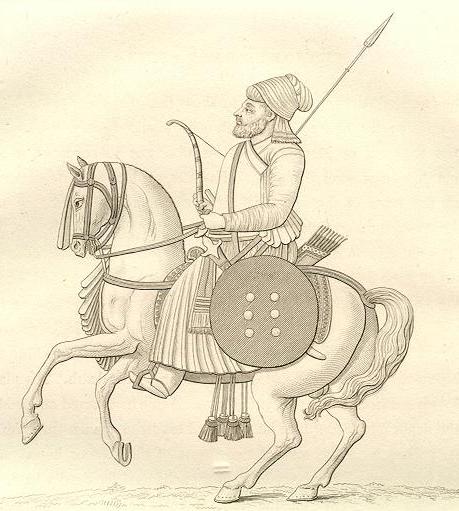
A Rajput warrior.
(image source: Annals
and Antiquities of Rajasthan: or the Central and Western Rajput States of India
- By Colonel James Tod).
***
Chemical warfare
Kautilya wrote in the Arthashastra that a ruler
could use any means to attain his goal, and Book XIV touches on aspects of
chemical and biological warfare.
The book says that smoke from burning a powder
made from the skin and excreta of certain reptiles, animals and birds can cause
madness and blindness in the enemy.
The book also provides the formula to create a
lethal smoke by burning certain species of snakes, insects and plant seeds in
makeshift laboratories.
"Our focus at present is on how humans can
control hunger for longer durations and walk for longer period without
experiencing fatigue,
Project leader Dr V S Ghole, head of the
environmental engineering department of Pune university, said the team was now
focusing on the methods of controlling hunger and increasing stamina.
"Once we have made some headway we will go
into researching Kautilya's notes on night vision and other fields," he
said.
Professor S V Bhavasar said the team also had
plans to research other ancient Hindu texts.
These include manuscripts which "claim to
provide secrets of manufacturing planes which can not be destroyed by any
external force, could be motionless in the sky and even invisible to enemy
planes."
(source: http://news.bbc.co.uk/hi/english/world/south_asia/newsid_1986000/1986595.stm).
Refer to
Shastar Vidya
For
more refer to chapter on Greater
India: Suvarnabhumi and Sacred
Angkor
Top
of Page
 Did
You Know? Did
You Know?
Gun powder (Agnicurna)
and Ancient Hindus
Sir A.
M. Eliot tells us that the Arabs learnt the manufacture of gunpowder
from India, and that before their Indian connection they had used arrows of
naptha. It is also argued that though Persia possessed saltpetre in abundance,
the original home of gunpowder was India. It is said that the Turkish word top
and the Persian tupang or tufang are derived from the Sanskrit word dhupa. The dhupa of the Agni Purana means a rocket,
perhaps a corruption of the Kautaliyan term natadipika.
(source: Fire-Arms in Ancient India - By Jogesh
Chandra Ray I.H.Q. viii. p. 586-88).
(For
more refer to article by G R Josyer - India:
The Home of Gunpowder and Firearms).
Heinrich
Brunnhofer (1841-1917) German Indologist, also believed that the
ancient Aryans of India knew about gunpowder.
(source: German
Indologists: Biographies of Scholars in Indian Studies writing in German
- By Valentine Stache-Rosen. p.92).
Gustav Oppert
(1836-1908) in his work, Political Maxims of the
Ancient Hindus, says, that ancient India was the original home of
gunpowder and fire-arms.
It is probable that the word Sataghni referred to in
the Sundara Kanda of the Ramayana refers to cannon.
(source: Hindu
Culture and The Modern Age - By Dewan Bahadur K.S. Ramaswami Shastri
- Annamalai University 1956 p. 127).
Professor
Horace Hayman Wilson says: “Amongst ordinary weapons one is named vajra,
the thunderbolt, and the specification seems to denote the employment of some
explosive projectile, which could not have been in use except by the agency of
something like gunpowder in its properties.”
"The Hindus, as we find from their medical
writings, were perfectly well acquainted with the constituents of gun-powder -
sulphur, charcoal, saltpetre - had them all at hand in great abundance. It is
very unlikely that they should not have discovered their inflammability, either
singly or in combination. To this inference a priori may be added that draws
from positive proofs, that the use of fire as weapon of combat was a familiar
idea, as it is constantly described in the heroic poems."
(source: Essays
and lectures on the religions of the Hindus - H H Wilson vol. II p.
302)
It is very unlikely that they should not have discovered
their inflammability, either singly or in combination. To this inference a
priori may be added that drawn from
positive proof, that the use of fire as a weapon of combat was a familiar idea,
as it is constantly described in the heroic poems.”
The testimony of ancient Greek writers, who, being themselves
ignorant of fire-arms used by Indians, give peculiar descriptions of the mode of
Hindu warfare is significant. “Themistius mentions the Brahmin fighting at a
distance with lightning and thunder.”

Goddess Kali
at war
***
Alexander, in a letter to Aristotle, mentions, “the
terrific flashes of flame which he beheld showered on his army in India.” (See
Dante’s Inferno, XIV, 31-7).
Speaking of the Hindus who opposed Alexander, Lord
Elphinstone says: “Their arms, with the exception of fire-arms,
were the same as at present.”
(source: History
of India - by Mountstuart Elphinstone p. 241).
Philostratus thus speaks
of Alexander’s invasion of the Punjab: “Had Alexander passed the Hyphasis he
never could have made himself the master of the fortified habitations of these
sages. Should an enemy make war upon the, they drive him of by means of tempests
and thunders as if sent down from Heaven. The Egyptian Hercules and Bacchus made
a joint attack on them, and by means of various military engines attempted to
take the place. The sages remained unconcerned spectators until the assault was
made, when it was repulsed by fiery whirlwinds and thunders which, being hurled
from above, dealt destruction on the invaders.”
(source: Philostrati Vit: Apollo, Lib II. C. 35).
Commenting on the stratagem adopted by King Hal in the battle
against the king of Kashmir, in making a clay elephant which exploded, H M.
Elliot says: “Here we have not only the simple act of explosion but something
very much like a fuse to enable the explosion to occur at a particular
period.”
(source: The History of India, as
told by its own Historians - By H. M Elliot volume I. p. 365).
Though the Hindu masterpieces
on the science of war are all but lost, yet there is sufficient material
available in the great epics and the Puranas to prove that fire-arms were not
only known and used on all occasions by the Hindus, but that this branch of
their armory had received extraordinary development. In medieval India, of
course, guns and cannons were commonly used. In the 12th century we
find pieces of ordnance being taken to battle fields in the armies of Prithviraj.
In the 25th stanza of Pritviraja Rasa it is said that “The calivers
and cannons made a loud report when they were fired off, and the noise which
issued from the ball was heard at a distance of ten cos. An Indian historian,
Raj Kundan Lall, who lived in the court of the King of Oudh, says that there was
a big gun named lichhma in the possession of His Majesty the King (of Oudh)
which had been originally in the artillery of Maharaja of Ajmer. The author
speaks of a regular science of war, of the postal department, and of public
roads. “Maffei says that the Indians far excelled the Portuguese in their
skill in the use of fire-arms.”
Another author quoted by Peter
Von Bohlen (1796-1840)
German Indologist, speaks of a certain Indian king being in the habit of placing several pieces of
brass ordnance in front of his army. “Faria-e-Souza speaks of a Guzerat vessel
in A.D. 1500 firing several guns at the Portuguese, and of the Indians at
Calicut using fire vessels in 1502, and of the Zamorin’s fleet carrying in the
next year 380 guns.”
(source:
Hindu Superiority -
By Har Bilas Sarda p.
355-360).
In the light of the above
remarks we can trace the evolution of fire-arms in the ancient India. There is
evidence to show that agni (fire) was praised for vanquishing an enemy. The
Arthava Veda shows the employment of fire-arms with lead shots. The Aitareya
Brahmana describes an arrow with fire at its tip. In the Mahabharata and
Ramayana, the employment of agnyastras is frequently mentioned, and this
deserves careful examination in the light of other important terms like ayah,
kanapa and tula-guda.
The agnicurna or gunpowder was composed of 4 to 6 parts of saltpetre, one part
of sulphur, and one part of charcoal of arka, sruhi and other trees burnt in a
pit and reduced to powder. Here is certain evidence of the ancient rockets
giving place to actual guns in warfare. From the description of the composition
of gunpowder, the composition of the Sukraniti
can be dated at the pre-Gupta age.
(source: War
in Ancient India - By V. R. Ramachandra Dikshitar 1944. p. 103 -105).
Medhatithi
remarks thus "while fighting his enemies in battle, he shall not strike
with concealed weapons nor with arrows that are poisoned or barbed on with
flaming shafts."
Sukraniti
while referring to fire-arms, (agneyastras) says that
before any war, the duty of the minister of war is to check up the total stock
of gunpowder in the arsenal. Small guns is referred as tupak by Canda Baradayi.
The installation of yantras (engines of war) inside the walls of the forts
referred to by Manasollasa and the reference of Sataghni (killer of hundreds of
men) pressed into service for the protection of the forts by
Samaranganasutradhara clearly reveals the frequent use of fire arms in the
battle-field.
(source: India
Through The Ages: History, Art Culture and Religion - By G. Kuppuram
p. 512-513).
The use of gunpowder, first
invented and used in India as an explosive mixture of saltpetre, sulfur and
charcoal to power guns, cannons and artillery.
(source: How
to Read the Timeline Hinduism Today).
H. H.
Eliot, Foreign Secretary to the Government of India (1845), after
discussing the question of the use of fire-arms in ancient India, says: "On
the whole, then, we may conclude that fire-arms of some kind was used in early
stages of Indian history, that the missiles were explosives....that projectiles
were used which were made to adhere to gates and buildings, and machines setting
fire to them from a considerable distance; that it is probable that saltpetre,
the principal ingredient of gunpowder, and the cause of its detonation, entered
into the composition, because the earth of Gangetic India is richly impregnated
with it in a natural state of preparation, and it may be extracted from it by
lixiviation and crystallization without the aid of fire; and that sulphur may
have been mixed with it, as it is abundant in the north-west of India."
(source: Historians of M India -
Bibliographical Index. Vol. I p. 373).
Horace
Hayman Wilson wrote: "Rockets appear to be of Indian invention,
and had long been used in native armies when Europeans came first in contact
with them." "It is strange that they (rockets) should now be regarded
in Europe as the most recent invention of artillery."
(source: Annals
and Antiquities of Rajasthan: or the Central and Western Rajput States of India
- By James Tod South Asia Books; ; 2
edition (April 1998) ISBN 8120803809 Vol. II p. 220 and (source: Historians of M
India - Bibliographical Index. Vol. I p. 373 and 357).
***
(For
more refer to article by G R Josyer - India:
The Home of Gunpowder and Firearms).
  
Images
of Some Weapons

Maharatha weapons
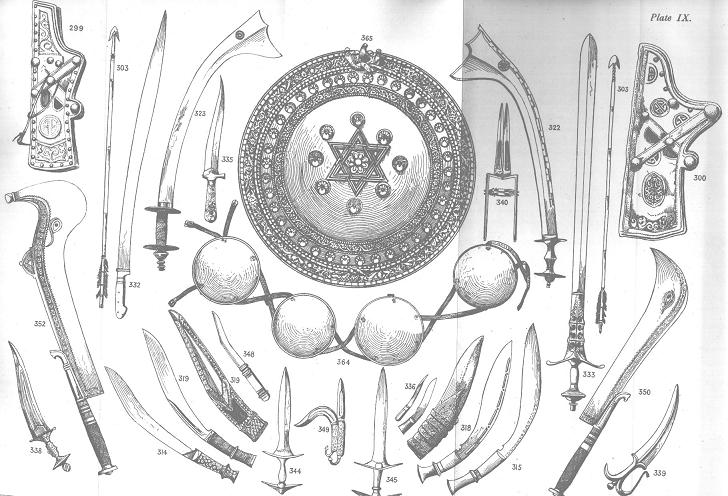
Nepal
weapons

Central
India weapons

India
- Persia weapons
(image source: Arms,
armour: weapons and accoutrements of warriors in Bharat through the ages -
hindunet.org).
Top
of Page
|